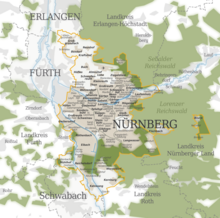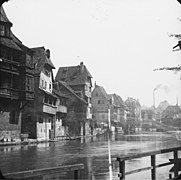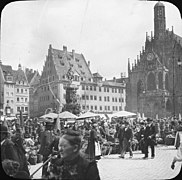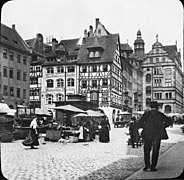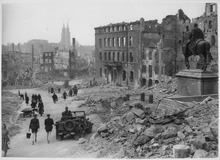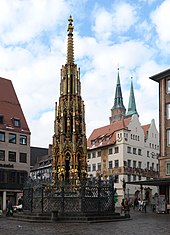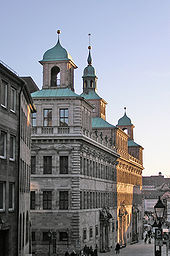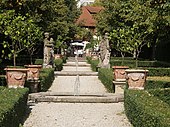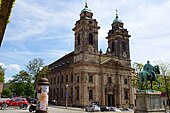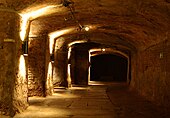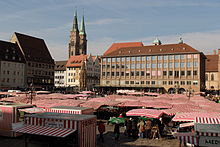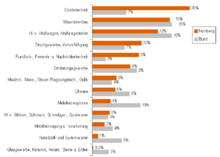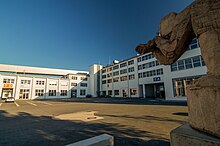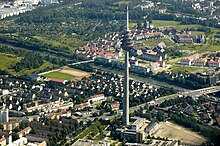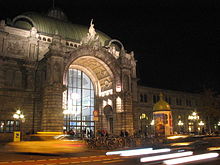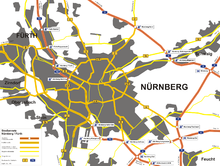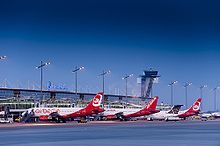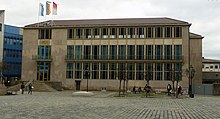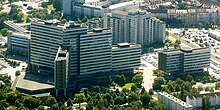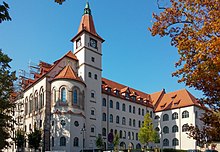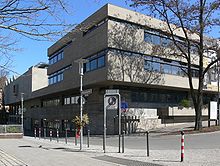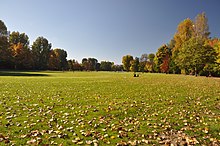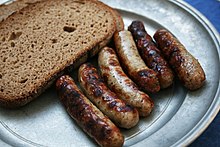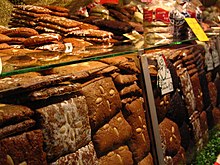Nuremberg
| coat of arms | Germany map | |
|---|---|---|

|
Coordinates: 49 ° 27 ' N , 11 ° 5' E |
|
| Basic data | ||
| State : | Bavaria | |
| Administrative region : | Middle Franconia | |
| Height : | 309 m above sea level NHN | |
| Area : | 186.38 km 2 | |
| Residents: | 518,370 (Dec. 31, 2019) | |
| Population density : | 2781 inhabitants per km 2 | |
| Postcodes : | 90402-90491 | |
| Primaries : | 0911, 09122, 09129 | |
| License plate : | N | |
| Community key : | 09 5 64 000 | |
| LOCODE : | DE NUE | |
| NUTS : | DE254 | |
| City structure: | 7 boroughs | |
City administration address : |
Rathausplatz 2 90403 Nuremberg |
|
| Website : | ||
| Lord Mayor : | Marcus König ( CSU ) | |
| Location of the city of Nuremberg in Bavaria | ||

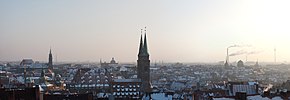


Nuremberg ( nürnbergisch often Närmberch ) is a Frankish county-level city in the district of Middle Franconia the Free State of Bavaria .
With around 520,000 inhabitants, Nuremberg is the second largest city in Bavaria after Munich , and is showing significant growth, making it one of the 15 largest cities in Germany . Together with the direct neighboring cities of Fürth , Erlangen and Schwabach , Nuremberg forms one of the three metropolises in Bavaria with around 800,000 inhabitants . Together with the surrounding area, these cities form the Nuremberg metropolitan area , with over 1.3 million people, and the economic and cultural center of the European metropolitan region of Nuremberg , one of the eleven metropolitan regions in Germany , with a population of almost 3.6 million .
The city of Nuremberg was mentioned for the first time in the Sigena document from 1050, it experienced its first heyday as an independent imperial city of the HRR from 1219. Before the severe destruction in the Second World War and the very simplified rebuilding of the post-war period , Nuremberg's medieval old town was valid as one of the most important in Europe. However, some landmarks have been faithfully rebuilt, especially the city's churches . In addition, some architectural monuments have been preserved. The most important landmarks include some buildings along the historic mile , especially the Nuremberg Castle . In addition, other noble buildings and castles of the old HRR imperial city have been preserved.
Nuremberg's Christkindlesmarkt , the Germanic National Museum and several other museums are also of national importance . Global perception reached the city in the 20th century during the time of National Socialism , than on the Nazi Party Rally Grounds , the annual party rallies were held and the Nuremberg Laws were adopted. After the Second World War, however, with the Nuremberg trials , the city became the scene of the first judgments based on international criminal law and acquired the title city of human rights . Economically, the service industry, cutting-edge technology, industrial production (including electrical engineering, mechanical engineering and automotive parts) and the Nuremberg Exhibition Center (including Spielwarenmesse , Consumenta , GaLaBau , BIOFACH ) are of great importance. Nuremberg is also the seat of the state authorities Federal Employment Agency and Federal Office for Migration and Refugees .
Name, coat of arms and logo

The name of the city is derived from nor for "stony rock" and referred to the Keuperfels, visible from afar, with the castle. They and the settlement at their feet were probably named after the rock mountain. There is also the thesis that the name of the city is derived from the personal name Noro . Other interpretations such as “Nero-berg”, “Nur-ein-Berg” or “Neuberg” turned out to be wrong.
The nickname Noris came up in humanism . For the first time Helius Eobanus Hessus referred to Nuremberg as "noris amoena" (lovely Noris). Hessus leaned on the Latin spelling of the city name in documents as "Noricum", "Noribergae" or "Norimberg". In 1650, the doctor Johann Helwig personified this epithet in a poem as the mythical nymph Noris, which has since been used frequently as an educational allegory of the city.
| Great coat of arms | |
| Blazon : "On a light blue background a golden eagle with a naturally colored youthful king's head, which wears a golden crown of leaves and is framed by flowing hair." | |
| Reasons for the coat of arms: This coat of arms was already used in the seal of 1220 and symbolizes the empire ( imperial city ). The head was at times depicted as a woman's head. In its current form, the Great Coat of Arms was awarded in 1936 and confirmed by the city council in 1963. It is usually in the official seals (but not by the registry office, which bears the official Bavarian coat of arms), by the mayors and by the city council and on historic city buildings and may only be used with a special permit, which is rarely granted, by associations or Firms are used. |
| Small coat of arms | |
| Blazon : "In a split shield on the right golden half of the half black imperial eagle with red tongue, golden muzzle and golden beak, while the other half is divided five times diagonally to the right, beginning with red at the top and alternating in the colors red and silver." | |
| Foundation of the coat of arms: The inclined division can be traced back to 1260. The imperial eagle was added from 1350 and thus represented the back seal. This image has been used in the seals of the offices and foreign authorities of Nuremberg since 1513, whereby the number of inclined bars and the coloration varied several times. The shape still in use today was given in 1936 together with the great coat of arms. |
Both city coats of arms are subject to approval.
| The city flag is also derived from the small coat of arms . The small coat of arms may be used for advertising purposes by companies based in Nuremberg or affixed to goods, as long as the impression of official use is not created and the coat of arms is reproduced heraldically and artistically correctly. |

The city has used a signet alongside traditional coats of arms since the 1970s. The original signet, also known as the logo, showed a stylized N, which is reminiscent of the side of the small town's coat of arms, which is divided by red and silver. In 1993, a city logo was developed that took up the elongated silhouette of Nuremberg Castle and established itself as a symbol of the city. However, it was not possible to develop a uniform corporate design from this. In addition, the old logo proved to be inflexible due to its horizontal shape. In 2009 there were efforts in the town hall to develop a more manageable logo and a more uniform appearance. The new city logo and corporate design have been introduced gradually since July 2011. In addition to the city logo, the logo of the metropolitan region of the same name is also frequently used by the city. This is intended to make the connection between the urban region and the agglomeration with the neighboring districts more visible to the public.
geography

Geographical location
Nuremberg lies on both sides of the Pegnitz , which rises around 80 kilometers northeast of the city and crosses the city over a length of around 14 kilometers from east to west. In the area of the old town, the river was heavily canalized. In the western district of Doos , the Pegnitz leaves the urban area at Nuremberg's lowest point at an altitude of 288 m above sea level. NN and flows together with the Rednitz in Fürth to form the Regnitz . Especially in the north and north-west of Nuremberg, the landscape is strongly influenced by the alluvial river Pegnitz. In the north of Nuremberg, the Knoblauchsland is an important vegetable growing area. The Nuremberg Reichswald extends to the south, east and north of the city .
The subsoil of Nuremberg consists of soft sandstone that was created in the Keuper . To the north-east of Nuremberg is Franconian Switzerland , a low mountain range with a height of sometimes over 600 meters above sea level.
Expansion of the urban area
The area of the city covers an area of 186.38 km². In the west, the development has grown together with the neighboring town of Fürth and in the southwest with stone . To the north of the city lies the fertile Knoblauchsland, which also forms the western approach lane for the Nuremberg airport , and to the northeast the Sebalder Reichswald .
The northern boundary of the old town is formed by the castle hill with the Nuremberg Castle and the city wall , which has largely been preserved ; a little to the east, also on the north side of the Pegnitz, rises the park-like Rechenberg.
City structure
In 1968 the urban area was divided into 87 statistical districts and into blocks for planning purposes in the sense of a small-scale structure. These statistical districts are summarized in 10 statistical city districts. This administrative division, however, hardly plays a role in the consciousness of the population; rather, everyday life is based on the traditional names of the places.
Incorporations
Until 1825 the urban area covered 160.84 hectares. Since then, after the population of the city had increased more and more as a result of the industrial revolution and the city had expanded, several formerly independent municipalities were incorporated into the urban area, so that the city today over an area of about 186.4 km².
Neighboring communities
The city of Nuremberg borders on the following cities, municipalities and unincorporated areas (starting in the north, following clockwise):
Erlangen (independent city), Neunhofer Forst , Kraftshofer Forst and Erlenstegener Forst ( district of Erlangen-Höchstadt ), Schwaig near Nuremberg , Laufamholzer Forst , Zerzabelshofer Forst , Forsthof , municipality-free area Fischbach , Feuchter Forst and Feucht (all districts of Nürnberger Land ), Wendelstein and Forest Kleinschwarzenlohe ( district of Roth ), Schwabach (independent city), Rohr (district of Roth), Stein and Oberasbach ( district of Fürth ) and Fürth (independent city).
To the exclave Brunn , in which at 406 m above sea level. NN is the highest point of Nuremberg, border the municipality-free areas Brunn , Winkelhaid and Fischbach (all in the district of Nürnberger Land).
climate
Nuremberg has a humid, cool, temperate transitional climate that is neither very continental nor very maritime. The monthly average temperatures fluctuate between −1.4 ° C in January and 18 ° C in August, but peak temperatures of over 35 ° C are reached on some days in summer. The annual mean temperature is around 10.45 ° C. The amount of precipitation is somewhat less than usual for the geographic location. The reason for this is the location of Nuremberg in the Franconian Basin; this weak basin position keeps humid air masses away from the urban area. From time to time there are violent storms and thunderstorms over Nuremberg, most recently on August 28, 2006, when a tornado in the Gartenstadt district damaged several houses, some seriously.
| Nuremberg | ||||||||||||||||||||||||||||||||||||||||||||||||
|---|---|---|---|---|---|---|---|---|---|---|---|---|---|---|---|---|---|---|---|---|---|---|---|---|---|---|---|---|---|---|---|---|---|---|---|---|---|---|---|---|---|---|---|---|---|---|---|---|
| Climate diagram | ||||||||||||||||||||||||||||||||||||||||||||||||
| ||||||||||||||||||||||||||||||||||||||||||||||||
|
Average monthly temperatures and rainfall for Nuremberg
Source: DWD, data: 2015–2020; wetterkontor.de
|
||||||||||||||||||||||||||||||||||||||||||||||||||||||||||||||||||||||||||||||||||||||||||||||||||||||||||||||||||||||||||||||||||||||||||||||||||||||||||||||||||||||||||||||||||||
population
Population development
With the onset of industrialization in the 19th century, the population grew rapidly. While only 25,176 people lived in the city in 1808 and around 77,600 people in 1867, the number of inhabitants of Nuremberg exceeded the limit of 100,000 in the course of 1881 and made it a major city . At the end of 1897 the city had 183,397 and 1900 already over 250,000 inhabitants, by 1972 this number doubled to the high of the 20th century of 515,000. By 1985 the population fell to 465,000, after which it rose again. On December 31, 2008, the official population for Nuremberg was 503,638 according to an update by the Bavarian State Office for Statistics and Data Processing.
In the 2011 census, the population fell by around 20,000 and again fell below the half-million mark. On December 31, 2014, the state official population was 501,072 and the city-internal number of the population register was also 516,770. On December 31, 2017, the state official population was 515,201 and the city's internal population register was also 532,194. At the end of December 2018, this urban counting method resulted in 535,746 people with their main residence in Nuremberg. Overall, the number of residents in Nuremberg has increased by 4.4% over the past five years.
| year | population | Remarks |
|---|---|---|
| 1449 | 18,420 | |
| 1806 | 25.176 | in 3,289 houses |
| 1818 | 26,854 | |
| 1852 | 53,398 | thereof 46,184 Protestants , 6,633 Catholics and 155 Reformed |
| 1858 | 54.902 | |
| 1861 | 58,081 | in 3,315 houses |
| 1871 | 83.214 | on December 1, 1871, including 2,579 active military personnel, in 6,646 residential buildings, of which 14,852 Catholics, 65,803 Protestants, 301 Reformed, one Greek Orthodox , three Anglicans , 46 German Catholics , 301 free religious , 1,831 Israelites , three members of other denominations |
| 1875 | 91,018 | |
| 1880 | 99,519 | |
| 1885 | 114,891 | |
| 1890 | 142,590 | |
| 1900 | 261,081 | of which 179,464 Protestants, 74,413 Catholics; the inner city had 211,329 inhabitants |
| 1905 | 294,431 | with the garrisome (an infantry regiment No. 14, four squadrons Chevaulegers No. 1, a squadron hunters on horseback , a field artillery regiment No. 8) and including the 13 suburbs, including 196,907 Evangelicals, 86,939 Catholics, 6,819 Jews |
| 1910 | 333.142 | thereof 218,015 Evangelicals, 103,464 Catholics |
| 1925 | 392.494 | thereof 249,780 Evangelicals, 126,318 Catholics, 721 other Christians, 8,603 Jews |
| 1933 | 410,438 | thereof 257,201 Evangelicals, 131,606 Catholics, 225 other Christians, 7,502 Jews |
| 1939 | 420,349 | of which 256,791 Protestants, 137,750 Catholics, 1,536 other Christians, 2,589 Jews |
| 1950 | 362,459 | |
| 1960 | 452,400 | 65,400 of them displaced |
life quality
In the Worldwide Quality of Living Survey by the consulting firm Mercer, Nuremberg was once again among the top 25 cities with the best quality of life worldwide, and in 2010 it was sixth among German cities. Among other things, social , economic and environmental criteria as well as culture , educational offers , infrastructure and health care were taken into account. In the environmental ranking, Nuremberg came in 13th as the best German city. In 2018, Nuremberg was ranked 23rd worldwide in this study, and thus ranked 6th in the comparison of German cities. In the special ranking of waste disposal and hygiene , Nuremberg was ranked 14th worldwide and 1st among German cities.
Population by nationality
As of December 31, 2014, the following lived in Nuremberg:
| rank | nationality | Population (December 31, 2014) |
Percentage |
|---|---|---|---|
| 1. | Germans without a migration background | 298,421 | 58% |
| 2. | Germans with a migration background | 116.215 | 23% |
| 3. | Foreigner (EU) | 47,421 | 9% |
| 4th | Foreigners (non-EU) | 54,713 | 11% |
| 5. | total | 516.770 | 100% |
dialect
The Nuremberg dialect belongs to the East Franconian dialect group , but it has clear features of North Bavarian (for example, overturned diphthongs ) and forms a transition between the two dialect groups. Research today assumes that in the late Middle Ages the city dialect still predominantly tended to North Bavarian. In the past 200 years, on the other hand, there has been a shift from Bavarian to East Franconian features, although there was a high influx from the Upper Palatinate in the industrial age. The dialect of the neighboring city of Fürth is very similar except for differences in the plural formation and diminutive forms. Several authors such as Fitzgerald Kusz or Klaus Schamberger still use the city dialect. Some are members of the Collegium of Nuremberg Dialect Poets . The town dialect is rarely used among the younger population. One often encounters Nuremberg Franconian in the media , which is based more on colloquial forms than on the threatening urban dialect. The Nuremberg dialect was documented through sound recordings as part of the compilation of the Bavarian Language Atlas and a grammar published in 1907.
Religions and worldviews
Denomination statistics
According to the 2011 census , 31.9% of the population were Protestant , 27.4% Roman Catholic and 40.7% were non-denominational , belonged to another religious community or did not provide any information. The number of Protestants and Catholics has fallen since then. At the end of 2019, Nuremberg had 535,886 inhabitants, of which 25.2% were Protestant, 22.8% Catholic and "other" 52.0%. A year earlier, 25.9% were Protestant, 23.5% Catholic and “other” 50.6%.
According to the 2011 census , 4.5% were Orthodox (21,910 inhabitants), 0.7% members of Protestant free churches (3,330 inhabitants) and 0.4% Jewish (2,090 inhabitants) .According to a calculation from the figures for people with a migration background, the Population share of Muslims in Nuremberg on the census date 8.1 percent (around 39,300 inhabitants).
Christianity

The area of the later Nuremberg originally belonged to the diocese of Eichstätt . From 1016 the area north of the Pegnitz was assigned to the Bamberg diocese . In 1525 the imperial city of Nuremberg introduced the Reformation according to the Lutheran creed. After that it remained a Protestant city for centuries. Only the extra-territorial area of the Teutonic Order's settlement remained Catholic.
Protestantism
After the city passed to Bavaria in 1808, the Protestant residents belonged to the Protestant Church of the Kingdom of Bavaria , which initially comprised Lutheran and Reformed communities. In the same year the general dean's office , in 1810 the dean's office in Nuremberg and in 1934 the church district in Nuremberg were established. The parishes of the city of Nuremberg are now part of the Nuremberg deanery with five vice-deaneries (Nuremberg-Mitte, -Nord, -Est, -West and -Süd). Nuremberg is the bishopric of the eponymous parish of the Evangelical Lutheran Church in Bavaria.
The Evangelical Lutheran Church maintains an ecclesiastical school, the Wilhelm Löhe School in Nuremberg as an evangelical cooperative comprehensive school, a university of applied sciences and the Eckstein House as a city academy. Diaconal institutions for older people, clinics and technical schools are supported by Diakoniewerk Neuendettelsau. The Rummelsberger Diakonie is also involved in the Nuremberg area with various institutions. The Nuremberg City Mission has existed since 1885 .
The Reformed parish had its own parish since the 19th century, and in 1853 it received its own synod together with the other Reformed parishes in Bavaria . In 1919 the Reformed parishes formally separated from the Protestant Church of Bavaria. Since then there have been two Protestant regional churches in Bavaria, the Evangelical Lutheran Church in Bavaria and the Reformed Synod in Bavaria on the right side of the Rhine, which has been called the Evangelical Reformed Church in Bavaria since 1949 and is now part of the Evangelical Reformed Church - Synod of Evangelical Reformed Churches in Bavaria and Northwest Germany (Synodal Association XI) is. About 30% of the residents of Nuremberg are of Protestant denomination. As of April 22nd, 2017, Nuremberg became the 96th city to bear the honorary title of “ Reformation City of Europe ” awarded by the Community of Evangelical Churches in Europe .
Roman Catholic Church
Since the 18th century at the latest, the number of Catholics in the city has increased again. In 1810 the first Catholic community in Nuremberg since the Reformation was established. In 1816 it was given the Frauenkirche for permanent use. Since then, other parishes have sprung up. In particular through the incorporation of Catholic suburbs in Nuremberg, the proportion of Catholics grew to a third of the population in the 20th century. Most of the 46 parishes in the city belong to the Nuremberg deanery of the Archdiocese of Bamberg . The parishes in the southern districts belong to the Deanery of Nuremberg-South of the Eichstätt diocese. Both dioceses have merged to create a uniform external image to form the Catholic City Church of Nuremberg. Many of the church institutions are housed in the house of the town church. About 26% of Nuremberg's residents are of the Roman Catholic denomination.
Further
In addition to the regional churches, there are a large number of Protestant free churches , some evangelical congregations, including almost 15 Pentecostal congregations (including foreign-language communities), two Evangelical Free Church congregations , four congregations of the Evangelical Methodist Church and congregations of the Mennonites , Mennonite Brothers , and a Free Evangelical congregation and six Seventh-day Adventist churches . Many regional and free church congregations are united in the Evangelical Alliance Nuremberg in order to carry out joint projects such as the prayer shop at the YMCA Kornmarkt or other inter-congregational projects. With its social work in Nuremberg with around 300 residents and 70 employees, the Salvation Army makes an important contribution to local social work in the homeless and drug addicts help.
The Apostolic Community , the Anglican Community and the International Baptist Church (with services in foreign languages) are also represented, as are the Independent Evangelical Lutheran Church and the Old Catholic Church , the latter in the Landauerkapelle .
The Orthodox denomination has been strongly represented in Nuremberg for decades with national church communities due to various waves of immigration. Immediately after the Second World War , a small Russian Orthodox community emerged. As a result, the Greek Orthodox parish of Saint Apostle Paulus, which has a large church at Oberen Kanalstrasse 35, and the Serbian Orthodox parish of Saints Cyril and Methodius at Kranichstrasse 4 were added. Nuremberg is the seat of the metropolitan area for Germany, Central and Northern Europe of the Romanian Orthodox Church . This maintains the Monastery of the Holy Martyrs Brâncoveanu and the parish of the Holy Martyrs Demetrios. The church at Fürther Straße 166 is decorated with frescoes in the Orthodox style. For the first time in centuries, Nuremberg became the seat of an archbishopric and metropolitan seat. With the parish of Blessed Xenia of Saint Petersburg there is also a parish of the Russian Orthodox Church . The Christian Orient is represented by three Coptic churches with Egyptian, Ethiopian and Eritrean characteristics; other Orthodox churches are Armenian, Iraqi and Chaldean characteristics.
There are also several congregations of the New Apostolic Church and Christian Science . The Jehovah's Witnesses and the Church of Jesus Christ of Latter-day Saints , also known as Mormons, have a number of congregations in Nuremberg.
Islam
In 1616, the translation of the Koran by Salomon Schweigger appeared in Nuremberg , the first translation into German.
Most of Nuremberg's Muslims are Sunnis . Since the beginning of 1970 there have been communities in Nuremberg to cultivate and promote the Islamic faith and culture. The Turkish Community, founded in 1974. V. is the oldest of these associations. The Islamic Cultural Center, founded in 1976, has been located in Spittlertorgraben with the Ayasofya Mosque since 1993 and is part of the Association of Islamic Cultural Centers in Cologne. The Turkish-Islamic Cultural Association has existed since 1979. In 1996, the Eyüp Sultan Mosque, the largest mosque in Bavaria and the third largest in Germany, was opened. The only mosque in Nuremberg that also offers German-language courses on a larger scale is that of the Islamic Community of Nuremberg (IGN).
The Shiites are present in Nuremberg with meeting and prayer centers.
Alevis
In Nuremberg there is an Alevi community and an Alevi cultural association.
Judaism


Otto of Freising reported first that in 1146 several Jews in Nuremberg recording found after they were expelled from the Rhineland, where the French Cistercian monk Radulf in advance of the Second Crusade to pogroms called. Probably there was a settlement southeast of the Sebalduskirche already earlier, which like the Egidienkloster lay outside the Sebald city walls and was included in the first expansion of the city in 1150. More recent archaeological studies could not confirm this settlement area. There had been no settlement in ghettos in the High Middle Ages, but today's fruit market could be considered as a settlement core. It is therefore assumed that relocation to the drained area on today's main market was not carried out until around 1250. The first synagogue is documented for 1296. In the course of the throne disputes between the Habsburgs and Nassauern, the persecution of the Jews began on a massive scale in southern Germany, starting in Röttingen , and the rint meat pogrom occurred . In Nuremberg the Jewish population fled to part of the castle, but this was burned down by the angry crowd. The Nuremberg Memor Book lists 628 dead. A short time afterwards, a return and resettlement was possible again. But as early as 1349, as a result of the plague pogroms, there were again massacres, in which 562 people, probably around a third of the Jewish community, fell victim to the riots. According to Konrad von Megenberg's report, the plague did not break out in the city until two years later, so that in addition to the motifs presented, the new construction of the main market and the enrichment were in the foreground, as the privileges granted by Charles IV suggest. Today's Frauenkirche was built on the site of the synagogue at the behest of Charles IV. Again the expulsion was followed by resumption. The new settlement area was at the former Jewish cemetery (at the later Judengasse / Wunderburggasse). From 1473 there were again plans to expel Jews.
In 1498, on the advice of the city , Maximilian I ordered the expulsion and expropriation. At the same time, the city council tried to avoid violent attacks, made them a criminal offense and ensured "security" through city servants. The Jews had to leave the city between February 20 and March 10, 1499. From 1528, however, a flourishing Jewish community developed in the immediate neighboring town of Fürth , which lasted into the 20th century. Settlement in Nuremberg was not permitted again until 1850, but Judaism in the city took off rapidly and already had members in 1871 1831. With the inauguration of the newly built synagogue in 1874 at today's Hans-Sachs-Platz, the Jewish community had a new home. In 1902 an Orthodox synagogue was consecrated on Essenweinstrasse . In 1922 the Jewish community in Nuremberg comprised 9280 members.
After the seizure of power of Hitler in 1933, numerous parishioners emigrated. The number of Nuremberg's Jewish population decreased by 5,638 between 1934 and 1940. As early as August 1938, Julius Streicher had the Nuremberg main synagogue torn down; the synagogue on Essenweinstrasse was burned down in the course of the November pogroms on the night of November 9-10, 1938. Mostly on the night of October 29, 1938, Jews were taken out of their apartments as part of the “ Poland Action ”, as in Nuremberg, transported in guarded trains and trucks to the German-Polish border and chased over. A total of 1631 Jewish people from Nuremberg fell victim to National Socialism.
Today's Israelitische Kultusgemeinde Nürnberg has had its seat in Johann-Priem-Strasse since 1984. However, according to its own information, the spatial capacity of this synagogue with currently 1999 members (as of 2013) is no longer sufficient.
The synagogue Adass Israel belongs to the orthodox branch of Judaism, and the synagogue of Chabad belongs to the Hasidic branch of Judaism .
Baha'i religion
The Baha'i religion is represented by a community in Nuremberg.
Hinduism
The Hinduism is in Nuremberg with a temple, Sri Sithivinayagar present, which is supported by a predominantly Tamil community.
Buddhism
Various Theravada , Mahayana and Vajrayana Buddhist communities are active in Nuremberg with study and meditation groups.
Vajrayana Buddhism includes the Buddhist Center, Theravada Buddhism the Buddhist Center Nürnberger LAND e. V. In 2009 the Thai community inaugurated its second Buddhist temple, Wat Thepwongsaram . The Bodhidharma temple in Nuremberg belongs to Mahayana Buddhism, especially the Zen / Chan tradition.
The Buddhist monastery Vinh Nghiem has existed in Nuremberg-Eibach since September 2012, which is run by the Vietnamese-Buddhist community of Franconia under the direction of monks from Vietnam and Germany. The monastery belongs to Mahayana Buddhism.
Other religious communities
The almost extinct religious community of the Mandaean community found refuge in Nuremberg .
Anthroposophy
The anthroposophy , their own roots in Nuremberg has is as a religious community in the Krelingstraße 26, with the Rudolf Steiner School and a cultural center, the Rudolf Steiner House, Rieterstraße 20 present.
Humanists
Nuremberg is also the seat of the Humanist Association , a recognized ideological community of non-religious people and a corporation under public law . Among other things, the association is the sponsor of a primary school in Fürth as well as over a dozen day-care centers in Nuremberg / Fürth and others in Regensburg and Munich. He also maintains the Tower of the Senses at the west gate of the Nuremberg city wall, a student dormitory in Steinbühl and its own social work.
history
Beginnings of the city
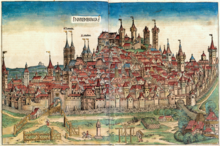
The first signs of settlement near today's main market are dated around the year 850. When the city was founded is not known, it could have been between 1000 and 1040 in the course of securing the border area between Saxony , Bavaria , Eastern Franconia and Bohemia at the intersection of important roads. Several early settlement centers can be made out. This probably included two royal courts around St. Egidien and St. Jakob as well as the area between Sebalduskirche and the castle . In any case, the settlement had market rights from the start . The 1050 by Emperor Heinrich III. The so-called Sigena certificate issued contains the date "nuorenberc" as the place of issue and is therefore the first documentary mention of Nuremberg. As an imperial base, the Nuremberg Castle (Kaiserburg) soon became important for the empire . In 1065, Henry IV formed his own high court and administrative district from the Reichsgut Nürnberg and the surrounding area . Conrad III. awarded the newly established burgraviate with court and administration to the noble free von Raabs (from Lower Austria ), in 1190/91 it was taken over by Friedrich I von Nürnberg-Zollern .
With the Great Letter of Freedom , King Friedrich II made Nuremberg a Free Imperial City in 1219 . The influence of the burgraves of Nuremberg was soon limited to the burgrave castle and ended completely when the last burgrave Friedrich VI. sold the fire site of the Burggrafenburg, south of the pentagonal tower of the imperial castle, destroyed by Nuremberg and Bavarians in 1420, to the city council of Nuremberg in 1427. From then on until the transition to the Kingdom of Bavaria , the political fortunes of the city were completely in the hands of this council, with the House of Hohenzollern holding the title Burgrave of Nuremberg until 1918.
Late Middle Ages and Early Modern Times

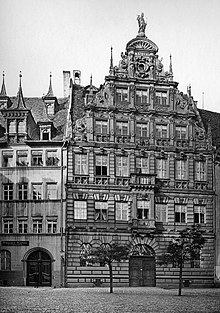
Many emperors gladly chose Nuremberg as their place of residence, including Charles IV , who issued the Golden Bull in Nuremberg in 1356 . In 1423 King Sigismund handed over the imperial regalia to the city, from which they were kept until the beginning of the 19th century. The years between 1470 and 1530 are generally considered to be the heyday of the city - despite recurring feuds and conflicts with knights like Götz von Berlichingen and Conz Schott von Schottenstein , but these were stopped after 1512 by the army of the Franconian Empire . From October 10 to November 6, 1485, Emperor Friedrich III stayed. in the city, about which the slogan Ruprecht Haller made a protocol of the ceremony when the emperor “rides in and out”. The city's wealth came from its excellent handicrafts and its favorable location as a trading center in the middle of Europe. The Nuremberg Stock Exchange served as a link in trade between Italy and other European economic centers. There was a lively exchange of goods with the Levant via Venice . During this time Nuremberg, along with Cologne and Prague, was one of the largest cities in the Holy Roman Empire .
During the Thirty Years War , the area around Nuremberg was the scene of a multi-year positional warfare between the warring parties. Although the city was not conquered, it was permanently economically weakened by the devastation in the surrounding area. After the war, the "Peace Supper" took place in Nuremberg in 1649, during which the conflicting parties sealed the peace in several days of festivities.
By the Reich Defense Order of 1681 Nuremberg was obliged to add nine companies to the three infantry regiments of the Frankish Reichskreis , which would be incorporated into the Reichsheer in the event of a Reich execution .
On October 13, 1792, the Kunstverein Nürnberg, Germany's first art association, was founded.
19th and early 20th centuries
Major events took place from 1796 to 1806. After urging the Prussian administration in neighboring Ansbach , Nuremberg finally submitted to Prussian rule. The treaty was not carried out as Prussia was deterred by Nuremberg's debts. At the same time, great resentment had built up in the Nuremberg population against the rule of patrician families, which was increasingly perceived as corrupt . These events shook the imperial city constitution to its foundations and brought the city to the brink of overthrow.
In the Reichsdeputationshauptschluss of February 25, 1803, Nuremberg initially remained independent until, after the signing of the Rhine Confederation Act and the end of the Old Empire, French troops occupied Nuremberg. On September 15, 1806, the French army finally handed the city over to the Kingdom of Bavaria , which immediately installed a civil administration and incorporated the city administratively into the kingdom. In 1806, the Kingdom of Bavaria took over the exorbitant debts of the imperial city of Nuremberg as part of the entire Bavarian national debt and thus ensured their consolidation and repayment. By the Bavarian legislation, the Catholics, who were previously only tolerated in the city, were legally equated with the Protestants. After the centralist reforms of Count Montgelas were repealed in 1817, Nuremberg received its own magistrate again in May 1818 and Friedrich Binder became mayor.
In order to promote industry and agriculture, an industrial and cultural association was founded in Nuremberg , which produced subsidiary organizations in Middle Franconia and adopted fixed statutes on December 27, 1830.
In the 19th century Nuremberg developed into one of the industrial centers in Bavaria. In 1835, for example, the “ Adler ” was the first passenger railroad in Germany to run from Nuremberg to Fürth.
In the 1840s, Nuremberg became a port city when the Ludwig-Danube-Main Canal , built from 1835 to 1846, reached the city. This led through Gostenhof and there was the trading port of Nuremberg for cargo handling. In 1950 the Ludwig Canal was opened again and in the 1960s it was almost completely built over with the Federal Highway 73 . Only the street name An den Rampen is reminiscent of the former port on the Ludwig Canal, which, thanks to its rail connection , offered trimodal cargo handling by ship / rail / road as early as 1845 .
Since 1841 Nuremberg was included in the plans of the Ludwig-Süd-Nord-Bahn , which ran from Lindau to Hof. This was the first railway in Bavaria, which was built on loans from Ludwig I (Bavaria) at state expense from the Eisenbahnbau-Commision. On October 1, 1844, the Nuremberg-Bamberg line went into operation. Shortly afterwards, the Nuremberg-Schwabach line was completed.
Rush gold was probably invented in Nuremberg in the second half of the 18th century .
Between 1870 and 1939, Nuremberg developed into a center for the toy and model railway industry. In addition, machine and electrical equipment, the two-wheeler and pencil industries were important branches of the economy and some of them still are today. Carl Marschütz founded the later Hercules factories here . The first bicycle factory in Germany was founded in Nuremberg. Well-known brand names such as Mars , Victoria and Zündapp are closely associated with the city. This branch of industry quickly established itself and became a stronghold of the two-wheeled industry.
The 17th German Fire Brigade Day took place in Nuremberg from July 24 to 27, 1909 .
Many small workshops up to large companies produced tin-plate toys. The Bing company stood out in particular , making the leap from manual production (cutting, soldering, painting) to industrial production (lithography, punching, lashing) and growing into the world's largest toy manufacturer thanks to its inexpensive products. Many of Nuremberg's toy production facilities were owned by so-called Jews . Numerous manufacturers fell victim to the " Aryanization " forced by the National Socialists between 1936 and 1938 .
In the 1920s, the first party rallies of the National Socialists took place in Nuremberg . In Nuremberg itself, the NSDAP was never able to win elections. The city was predominantly ruled by the liberal DDP . At the same time, due to its importance as an industrial location, Nuremberg was a center of Bavarian social democracy .
During the 1920s, Hermann Luppe held the office of Lord Mayor. He was elected Lord Mayor in 1920 to succeed Otto Geßler , and he was the only candidate. In the city council, Luppe worked together with the Social Democrats, who made up the vast majority of the city council during the Weimar Republic . On October 20, 1922, the first local group of the NSDAP in Nuremberg was founded by Julius Streicher . This marked the beginning of the rise of National Socialism in Nuremberg. In his fight against anti-Semitism , Luppe had arguments with Julius Streicher and the NSDAP. Among other things, there were several trials in court between him and Streicher for defamation and defamation by the National Socialists. After the Nazi seizure of power, Hermann Luppe was illegally arrested on March 18, 1933 and expelled from Nuremberg after his release.
During Hermann Luppe's term of office, Nuremberg pursued a progressive urban policy. He made significant achievements possible in the areas of education, social welfare, culture, architecture and urban planning. Among other things, new residential complexes, the women's clinic on Flurstrasse and the sports and leisure facilities were built.
time of the nationalsocialism
During the time of National Socialism , the National Socialists made Nuremberg one of the most important places of National Socialist propaganda as the “City of the Reich Party Rallies ”. The Nuremberg Laws , also known as the Nuremberg Race Laws, were passed unanimously on September 15, 1935 by the Reichstag at the 7th Reich Party Congress of the NSDAP ("Reich Party Rally of Freedom") in Nuremberg. These should serve the National Socialists as a legal basis for exercising their anti-Jewish sentiments.
- "Nuremberg - Albrecht Dürer was never great there, all the fame of the city was stolen by a party unknown to the muses, until explosives from the air disrupted their customs." - Heinrich Mann, an age is being visited.
Between 1941 and 1945 there were concentration camp prisoners from the Flossenbürg camp in sub -camps in the city . Several hundred prisoners worked in the Nuremberg SS barracks for the construction management of the Waffen SS and the Nuremberg police . From the concentration camp Nuremberg SS barracks and the small satellite camp Eichstätt has been established. October 18, 1944 to March 6, 1945 also existed the concentration camp Nuremberg (Siemens-Schuckert) , the 550 women prisoners forced labor work performed for the Siemens-Schuckert (SSW) in the Katzwanger road.
During World War II , Nuremberg was one of the frequent targets of Allied air raids that severely damaged the city. On January 2, 1945, the old town of Nuremberg was almost completely destroyed. Historic buildings were also destroyed in the five-day battle for Nuremberg in April 1945. After the war, there were considerations to completely abandon the destroyed city and to rebuild it elsewhere.
Post War and Reconstruction

After the Second World War, there was a shortage of food and housing in the city. Of the 134,000 apartments before the start of the war, only 14,500 were undamaged.
Martin Treu and Hans Ziegler were appointed the new Lord Mayors of the city by the American military government in July 1945. Parallel to the denazification at the municipal level, the Nuremberg trials against leading war criminals of the National Socialist dictatorship also took place from November 1945 in the Palace of Justice on Fürther Strasse . Since the Palace of Justice with the adjoining prison survived the war largely unscathed, Nuremberg was chosen as the place of the trials instead of Berlin, especially since Nuremberg, as the city of the Nazi party rallies, had a symbolic meaning similar to that of the capital or Munich.
At the beginning of 1948 an architecture competition decided to rebuild the largely destroyed city according to the development plans of Heinz Schmeißner and Wilhelm Schlegtendal . In 1949 the German Building Exhibition took place in Nuremberg under the motto “We have to build”. The reconstruction was largely based on the historical city structures, so that they can still be read in many places despite the largely destroyed building fabric. The roof landscape , in particular, has again been designed similar to the pre-war state. Many important church buildings have also been largely reconstructed , as well as buildings along the later Historical Mile such as the Reichsburg . Important town houses like the Toplerhaus and the Pellerhaus or the buildings on the main market were not or only partially rebuilt.
From the economic miracle until today
After the war, the city's economic profile changed. Traditional branches of industry such as the Nuremberg motorcycle industry (see also: Zweirad Union and Hercules ) could no longer build on the successes of the first half of the century. In contrast, companies such as AEG or Photo Porst expanded . At the end of the 1950s, there was still a shortage of 47,000 apartments. In 1957 the foundation stone for the new Langwasser district was laid by the municipal housing association, the wbg Nürnberg , the construction of which was the largest project to expand a city in the Federal Republic of Germany. In 1967 the last vacant lot was closed on the main market.

Nuremberg companies such as Siemens-Schuckert , Schöller-Eis , MAN , Zündapp and the office equipment manufacturer Triumph-Adler , which was taken over by the Fürth Grundig works in 1957 , played a major role in the so-called economic miracle . The number of employees in industry rose from 77,000 (1950) to 120,000 (1960). Nuremberg has gained particular importance through the Nuremberg Toy Fair , which has been held annually since 1950 and is now held in the exhibition center in Langwasser, which was completed in 1973. Other important infrastructure projects in the post-war period were: the opening of the airport in 1955 , the start of construction on an underground railway in 1967 and the completion of the Bayern port on the Main-Danube Canal in 1972 .
In 2006 the 1st day of the Franks was celebrated in Nuremberg . The venue was the Museum of Industrial Culture , in which the regional exhibition 200 Years of Franconia in Bavaria was presented at the same time . The main event took place in the Tafelhalle .
Buildings
Up until the Second World War, Nuremberg was the only major city in Germany in which the historic city center and its fortifications had remained almost unchanged. Aware of this outstanding cultural and art-historical importance, measures were taken to rescue and faithfully restore the most important buildings even before the destruction. In the end, only ten percent of the building mass survived the bombing unscathed. During the reconstruction, the city of Nuremberg decided, unlike most other German cities of the time, to preserve the structure of the old town and managed to integrate the valuable historical building fabric into an appropriate newer context. Therefore, the old town is not only a testimony to the Middle Ages and early modern times, but also to the reconstruction and modernity.
Romanesque (until approx. 1250)
The Nuremberg Castle is one with its history and architecture of the most important fortifications in Europe. The imperial castle, which under Konrad III. as soon as Friedrich Barbarossa was built, it retained its Romanesque design over the centuries , especially with the imperial chapel and the Heidenturm. The Nassauer Haus is the oldest building in the Lorenz district and dates back to the 12th century with its two lower floors. The Sebalduskirche is the older of the two main churches and was built on the site of a previous church building at the end of the Romanesque period (long nave) from around 1230 to 1275. During this time, the White Tower was also built as part of the penultimate city fortifications .
Gothic (until approx. 1500)
Between 1332 and 1339 the Heilig-Geist-Spital was built as a foundation of the wealthy citizen Konrad Groß . After the pogroms against the Jews, the Frauenkirche was built on the site of the former synagogue from 1349 on behalf of Charles IV . The beautiful fountain was created between 1389 and 1396 and shows the institutions of the time with 40 person sculptures in a hierarchical representation. The construction of the Lorenz Church began around 1250 and extended over three construction phases until 1477. It was also built on the site of a previous building. The Sebalduskirche received the Gothic hall choir.
The wealth of the city was evident in the living culture of the rich citizens, so that towards the end of the Gothic period numerous powerful town houses shaped the cityscape. A courtyard culture developed that came to full bloom in the Renaissance.
Around 1500 Nuremberg was the third largest city in the empire after Cologne and Prague , far ahead of Vienna or even Berlin. Therefore, the city has a large old town, which is surrounded by the Nuremberg city wall, which is largely preserved . There were numerous medieval churches, of which more have been preserved, such as the Gothic buildings of St. Martha , St. Jakob and St. Klara . The Katharinenkloster only exists as a ruin. Of the formerly numerous Gothic houses in the city, for example, the Albrecht Dürer House and the Unschlitthaus survived the last war relatively well. Others like the Weinstadel were later restored. Like the Dürerhaus, the Pilatushaus is a well-preserved example of a late medieval half-timbered house in Nuremberg.
Renaissance
The free imperial city pursued an expansion strategy typical for this time, so that from 1500 several patrician families also acquired mansions outside the city walls of that time. The landlord's castle , the Hummelstein manor , the Petzenschloss , the Schoppershof manor , Schübelsberg , the Tucherschloss , the Weigelshof and the Zeltnerschlösschen are well preserved and worth seeing .
From 1509 to 1513, the Sebastiansspital was built in the west of the city near Pegnitz and St. Johannisfriedhof . It was about the infection hospital (epidemic house) of the city and was also called "Lazarett". In the Second Margrave War it was destroyed, but in 1552 again again, but set up (in wood) without chapel.
From 1591 the stately Fembohaus was built . The Pellerhaus (1602–1605) was considered a major work of the German late Renaissance (partially destroyed in the war and rebuilt in a modern way; inner courtyard partially reconstructed). On the other hand, the Toplerhaus , which was rebuilt as a modern new building , is completely lost . The Hirsvogelsaal (1534) as an example of the patriciate's festival architecture was rebuilt. The Fleischbrücke was built in an arch from 1596–1598 by council builder Wolf-Jacob Stromer because of the current, modeled on the Rialto Bridge . Since it served as the main traffic artery, it had to be much flatter and for a long time was considered exceptional in the art of bridge construction.
The mighty Wolff town hall building was built between 1616 and 1622 and, with its stylistic elements, already indicates the transition to the later Baroque. It was partially destroyed during the Second World War and was only completely restored in a lengthy reconstruction phase relatively late in the 1960s.
Baroque and Rococo
The Baroque era did not change the cityscape, which was dominated by Gothic and Renaissance styles. The only baroque church in the old town is the Egidienkirche (baroque reconstruction 1711–1718); it already shows the stylistic transition to Rococo . Only a few baroque town houses have been preserved in the old town. The Maxplatz is still a rudimentarily preserved, planned baroque square in the northwestern old town.
In the St. Johannis district outside of the old town there are numerous baroque town houses and gardens ( Hesperidengärten ). A number of monuments from the Middle Ages as well as the Renaissance and Baroque periods have also been preserved in the Mögeldorf district .
The Neptune Fountain (1660–1668), the largest Baroque fountain north of the Alps, was sold to Peterhof Palace (Russia) in 1797 ; a second cast was on the main market from 1902 to 1934 and is now in the city park.
classicism
The classicistic church of St. Elisabeth has a 50 meter high dome completed in 1803. There are 40 Corinthian columns inside the church . Their arrangement means that each of the three church areas looks like an independent room. The Tucher'sche Palais on Egidienberg is also classicistic.
Early industrial age
Glass and iron were among the new, preferred building materials of the early industrial age. This is how the chain bridge was created .
historicism
The Villa Spaeth , built in 1890, Nuremberg Central Station , built in 1904, and the opera house, completed in 1906, all belong to the historicism style . There is also the Weißer Turm department store on Ludwigsplatz, the Grand Hotel on Bahnhofsplatz and the Palace of Justice on Fürther Straße .
With the Nuremberg style, historicism in Nuremberg sought to resume the Nuremberg building tradition of the late Gothic and Renaissance periods . This has experienced a special local expression. These included the Hotel Deutscher Kaiser , built from 1888 to 1889 , the Stein Castle , built in 1899, and the Hansa-Haus , built from 1893 to 1895 .
Art Nouveau and Reform Architecture
The Art Nouveau unfolded in Nuremberg first as a craft with commodities. As an architectural style, it only lasted for a relatively short time. Many large Art Nouveau buildings were already demolished in the National Socialist era (exhibition halls at Dutzendteich) and fell victim to World War II and demolitions in the 1950s and 1960s. Received are z. B.
- Art Nouveau district gardens behind the fortress ,
- Volksbad ,
- Bismarck School
- Entrance hall of the Germanic National Museum .
- Villa Hirsch
Ebenezer Howard's ideas for reform of the garden city movement were taken up by the city, which had grown and densified rapidly at the end of the 19th century. Shortly before the First World War, z. B. the
- Garden city of Nuremberg
- MAN factory settlement in Werderau , the aviation settlement .
- Residential colony marshalling yard ,
Classic modern
After the First World War, a number of classical modern buildings were built.
- Schocken department store on Aufseßplatz (1926 by Erich Mendelsohn , expanded in 1953 and 1963 and overbuilt the original building)
- Planetarium on Rathenauplatz (1927 by Otto Ernst Schweizer , demolished in 1934 at Julius Streicher's instigation )
- District heating plant of the municipal gas works (built in 1927 by Walter Brugmann )
- Gynecological Clinic in the North Clinic (1928–1931 by Robert Erdmannsdörfer)
- Milchhof (1930 by Otto Ernst Schweizer , only the former administration building remains)
- Poststadt on Allersberger Strasse (1928–1930 by Georg Kohl)
- Large residential complex Gibitzenhof , Dr.-Luppe-Platz (1929 by Ludwig Wagner-Speyer )
- House of Work (today: Karl-Bröger-Haus ) as the city's first high-rise (1929–1930 by Hans Müller and Karl Kröck )
- Nordostbahnhof settlement (1929–1931 by Karl Sorg and others)
- Tram waiting hall at Plärrer , so-called " Plärrer-Automat " (1931 by Walter Brugmann, removed in 1977)
- Administration building of the Franconian overland plant (today N-ERGIE ), Hainstraße (1930, extended and partly remodeled in a way that was not architectural, completely demolished in 2019)

National Socialism
During the time of National Socialism, Nuremberg was expanded by the National Socialists as the “City of the Reich Party Rallies”, of which numerous buildings have been preserved in the monumental architecture typical of this time.
- Reichsparteitagsgelände with Zeppelin Tribune, March Field and Grand Street (March Field towers blown up in 1967, now part of Langwasser)
- Congress hall (from 1935, unfinished, Ludwig Ruff )
- Südkaserne (former SS accommodation, 1938, Franz Ruff ) (currently Federal Office for Migration)
- Substation on the corner of Hans-Kalb-Straße / Regensburger Straße (currently used as system catering)
- Accommodation building on Regensburger Strasse (today a retirement home)
- former Gauleiter building on Willy-Brandt-Platz (today Verlag Nürnberger Presse)
Modern and post-modern

The Academy of Fine Arts of Sep Ruf is the first listed post-war architecture southern Germany. Of the other buildings built after the Second World War, the following should also be emphasized:
- Parish hall of the Ev. Parish church St. Leonhard , built as Bartning emergency church (type B) in 1949
- Ev. Gnadenkirche in Nürnberg-Schafhof, community center of Otto Bartning , inaugurated in 1951
- Theodor-Heuss-Bau of the Germanisches Nationalmuseum
- Plärrerhochhaus , one of the oldest skyscrapers in Bavaria
- planetarium
- Skyscraper of the Franconian overland works at the place of the victims of fascism (today N-ERGIE ) (currently, 2020, being demolished)
- Alcan works in Nuremberg-Sandreuth
- Extension building and new entrance foyer of the Germanisches Nationalmuseum in the Kartäusergasse with the street of the human rights
- Documentation center Nazi party rally grounds
- new museum
- Business Tower , the second tallest office building in Bavaria
- Administrative headquarters of the Federal Employment Agency
- Wüst interior design (architect: Niederwöhrmeier + Kief )
Between 1975 and 1977 the Nuremberg telecommunications tower was built in the Schweinau district . After the tower antennas were replaced in 2005, it is 292.80 meters high and the third largest telecommunications tower in Germany. The egg-shaped tower cage at a height of 185 meters gives the tower the nickname " Nuremberg Egg ". The programs of Sat.1 and RTLplus have only been broadcast since 1988 .
More Attractions
Also worth seeing in the city center are:
- Rock passages in the underground of the castle hill - Guided tours: Förderverein Nürnberger Felsengänge eV
- The hangman's bridge
- Thinking bunker
- The Ehekarussell fountain in front of the White Tower
- The Goose Man Fountain, a small fountain behind the Church of Our Lady
- Johannisfriedhof
- Rochus Cemetery
There are numerous stone crosses in Nuremberg , most of which are also listed as architectural monuments .
politics
City Councilor and Mayor
Nuremberg has been ruled by SPD mayors since 1945 (with two interruptions from 1996 to 2002 and since 2020 ).
The city council is the municipal representative of the people of Nuremberg. Every six years, citizens decide on the allocation of the 71 seats (70 city councilors and the Lord Mayor) in local elections ; the last elections took place on March 15, 2020 .
The SPD, CSU and Greens each form a parliamentary group . FDP, Free Voters (1 of 2 elected FW members of the council), Piraten, ÖDP and Die Guten together form a committee . Marcus König (CSU) has been Lord Mayor since May 1, 2020 , replacing Ulrich Maly (SPD), who was no longer up for re-election after an 18-year term in office. As part of the 2020 local elections , König prevailed in the runoff election on March 29 against the SPD candidate Thorsten Brehm with 52.2% of the votes cast. In the first ballot on March 15, König was clearly ahead with 36.5% of the vote. The next local election is scheduled to take place in 2026. The second mayor is Julia Lehner (CSU), responsible for the cultural department, the office for culture and leisure, the museums of the city of Nuremberg, the reuse of the Nazi party rally grounds, the city archive, the city library and other city cultural and educational institutions. The third mayor is Christian Vogel (SPD), who is responsible for the city fire brigade, the zoo, the administration of the city baths and the city's own service company for public spaces .
Town twinning
|
|
Nuremberg has a total of 15 city partnerships , representatives of this and the eight befriended cities present their own products (handicrafts, specialties, textiles, etc.) every year at the “market of the twin cities” as part of the Christmas market. Private groups of friends and youth exchanges intensify contacts as well as practical help; For example, the tram companies in Krakow and Antalya were given decommissioned, operational vehicles.
The first town twinning was concluded in 1954 with Nice and Venice together with an "oath of brotherhood" - signed by the mayors of the cities of Venice, Nuremberg, Nice, Locarno and Bruges - and reaffirmed in 2004 and 1999 respectively. The partnership with Krakow , which was concluded in 1979, presents the city of Nuremberg on its website as a “successful example of the cooperation between two cities, which was founded as a contribution to normalizing relations between two peoples”. The Kraków House exists in the Nuremberg Tratzenzwingerturm as an economic and cultural representative and a Nuremberg house in the Kazimierz district of Kraków . According to the city, one of the most intensive partnership relationships has existed with Skopje since 1982 . In addition to youth exchanges and mutual artist visits, there is another partnership project with the joint excavation of ancient Skopje by Macedonian archaeologists together with the Nuremberg Natural History Society . It started in spring 1998 and is expected to take 50 years to complete. The partnership with San Carlos in Nicaragua was initiated in 1984 by a Nuremberg citizens' initiative and was concluded during the Contra War in 1985. The city was promoted in particular through youth exchanges. The Sancarleños have, among other things, an expanded water supply, a new hospital building, humus latrines, a secondary school and a cultural center. Since the same year Nuremberg and Glasgow have been linked by a partnership after more than 30 years of intensive youth exchanges.
Aid was at the center of the partnership between Kharkiv and Nuremberg that was concluded in early 1990, as many of the liquidators deployed after the Chernobyl disaster came from there. With the support of the Chemical Investigation Office in Nuremberg, the Kharkiv Academy for Food Technology and Management is building a laboratory for the analysis of food for the whole of Ukraine in a pilot project. Trade relations had existed between Nuremberg and Prague since the middle of the 13th century, and a partnership agreement was signed in 1990. It took a long time before the partnership with Hadera came about . Since 1974 there have been regular exchanges between Germans and Israelis. Arno Hamburger , SPD city councilor and chairman of the Israelitische Kultusgemeinde Nürnberg, brought with him a signed friendship agreement from one of these exchanges in 1986, which was followed by an official town twinning agreement in 1995. In 1988 a town twinning agreement was signed with Gera in East Thuringia, which was then in the German Democratic Republic , which was converted into a friendship agreement in 1990 and updated again in 1997. A partnership with Antalya was also established in 1997. As part of a regional partnership between the cities and districts in the planning region of Nuremberg (at that time still the industrial region of Middle Franconia ) with the Shenzhen Special Economic Zone , the city partnership with Nuremberg was established. There is close exchange between the city zoos and between the Technical University of Nuremberg Georg Simon Ohm and the Shenzhen Polytechnic . In 1998 partnerships with Kavala in Greece and Atlanta in the USA were concluded. Trade relations with Venice already existed in the early 14th century . The Nuremberg merchants had a strong influence on the Central European markets for spices, silk and cotton. But they also exported Nuremberg trinkets , cloth, leather, honey and amber via Venice . Following on from this, a partnership was agreed in 1999.
After the Indian Ocean tsunami in 2004 , the city of Nuremberg in 2005 took over the sponsorship for Kalkudah on Sri Lanka .
2007 Nuremberg was for his efforts in the European integration thoughts with the European Prize of the European Union awarded.
As early as October 20, 1954, the mayors of Venice and Nuremberg, together with the representatives of Nice, Locarno and Bruges, took the so-called “brotherhood oath” on St. Mark's Square , in which it says (in German translation): “[...] oblige us Solemnly today to preserve the permanent ties between the municipal administrations of our cities, to support the exchange of their inhabitants in all areas and to promote the vigilant feeling of European fraternity through better mutual understanding [...] ”. On September 25, 1999, on this basis, it was only decided between Venice and Nuremberg to "re-establish their friendly relations".
On May 6, 2010, a town twinning agreement was signed with the Spanish city of Córdoba , which provides for exchange and cooperation on various levels. The initiative for this partnership came from the association Centro Español, which has existed since 1961, and its intercultural work.
After close relations with the Palestinian city of Nablus since 2004 , the mayors of the two cities signed a friendship agreement on September 23, 2019. The day before, Mayor Nablus attended the presentation of the Nuremberg International Human Rights Prize and thanked the city of Nuremberg for the support it had received over the past few years.
City friendships
|
City of Peace and Human Rights

Due to the role of Nuremberg during the National Socialist tyranny, the city feels particularly obliged to make an active contribution to peace and the realization of human rights.
For this purpose, among other things, the street of human rights , a memorial for human dignity and the documentation center Nazi party rally grounds, which informs about the time of National Socialism in Nuremberg, were built.
Since 1995 the International Nuremberg Human Rights Prize has been awarded to people who campaign for the observance of human rights.
The Nuremberg Human Rights Center , an association that campaigns for human dignity, and the Nuremberg Human Rights Office were founded. The German Human Rights Film Prize is awarded every two years . The Nuremberg Film Festival of Human Rights is an integral part of the city's cultural program.
The city of Nuremberg was awarded the UNESCO Prize for Human Rights Education on December 10, 2000 in Paris. With this, UNESCO recognized the exemplary commitment of the city of Nuremberg for peace and respect for human rights. The city of Nuremberg is applying for inclusion on the World Heritage List of UNESCO with Room 600 in the courthouse in which from 20 November 1945, the International Military Tribunal in session.
Every one to two years, the City of Nuremberg Prize is awarded to people with outstanding achievements in art and science.
economy
Nuremberg has local expertise in particular in the areas of information and communication technology , market research , printing , energy and power electronics, as well as transport and logistics . For 2015, gross value added at market prices of around 27 billion euros took place in the urban area . The service sector contributed about 77 percent and the manufacturing industry to 23 percent. The unemployment rate was about the national average, but well above the average in Bavaria. The retail turnover is 3.5 billion euros (as of 2014), which is the third highest per capita figure after Munich and Düsseldorf in Germany.
In 2018, Nuremberg achieved a gross domestic product (GDP) of € 28.130 billion within the city limits, placing it in 9th place in the ranking of German cities by economic output . In the same year, GDP per capita was € 55,000 (Bavaria: € 44,215, Germany € 38,180) and thus well above the regional and national average. In 2016 there were around 388,700 gainfully employed people in the city. The unemployment rate in December 2018 was 5.1% and thus above the Bavarian average of 2.7%.
In the Future Atlas 2019 , the city of Nuremberg was ranked 61st out of 402 districts, municipal associations and cities in Germany, making it one of the places with "high future opportunities".
Agriculture and Natural Resources
With the Knoblauchsland , Nuremberg has a large vegetable growing area of supraregional importance in the north, which is mainly known for its asparagus cultivation. Furthermore, in the vicinity of the incorporated Worzeldorf there is a sandstone deposit made of Worzeldorfer sandstone , which is of great art-historical importance for Nuremberg, as numerous buildings were built from this building material. The Nuremberg Reichswald, which is located in a community-free area around Nuremberg , has been a supplier of wood for centuries; there are also large opencast mines for construction sand.
Industry
Nuremberg is a center in the areas of information and communication industry, traffic and logistics, energy technology and power electronics. Nuremberg is Germany's most important printing location , ahead of Hamburg .
Nonetheless, Nuremberg has had to put up with plant closings and the relocation of jobs over and over again over the past 25 years. The mechanical engineering and household electronics division was particularly hard hit. The MAN site in the south of Nuremberg has been steadily reduced in size over time. At the end of the 1990s, 3,000 employees were laid off at subsidiaries and spin-offs. Office machine manufacturer Triumph-Adler began to decline in the mid-1980s . In 2003 around 1,300 jobs were lost in Nuremberg as part of the dissolution of the Grundig AG group. Between the first half of 2006 and March 2007, the AEG plant in Nuremberg closed with a loss of 1,750 jobs.
Important industrial companies in Nuremberg are the Diehl Group , Leoni and the Leistritz Group .
Services
Nuremberg is a national leader in the field of market research : every third German market researcher works here. For example, Nuremberg has several large companies in the service sector with Nürnberger Versicherung , DATEV or the Gesellschaft für Konsumforschung . In addition, Nuremberg is an important location for call centers and for companies in the new media sector. So have hotel.de and Immowelt based here. The formerly largest mail order Corporation Quelle GmbH was in June 2009 in insolvency and was disbanded in October. 3700 employees were unemployed in Nuremberg and Fürth , and there are further job losses at service providers such as DHL and suppliers.
Industrial estates or industrial parks
In the last 15 years in particular, numerous industrial estates and industrial parks have emerged in Nuremberg. The reason for the creation was often an inner-city reorganization, as former industrial areas had been abandoned after industry had left.
- Eurocom in the Langwasser district
- FrankenCampus on the former MAN administration site on Frankenstrasse in Südstadt
- Altenfurt industrial park
- Industrial park Moorenbrunn : Here is Siemens AG created a large administrative center.
- Nuremberg-Feucht industrial park on a former American airfield north of the munitions plant
- Hansapark in the Schweinau district
- Herkules-Park on Nopitschstraße on the former site of the Hercules works, later the SACHS motorcycle works were located there .
- High Tech Center Nuremberg
- Maxtorhof in Pirckheimerstraße, where the Schwan-Stabilo pencil factory used to be .
- Northeast Park
- Nürbanum in Allersberger Straße, formerly Felten & Guilleaume / TeKaDe , later Philips Communication Industry (PKI)
- Südwestpark in the Gebersdorf district
- TA site on Fürther Strasse. Former location of the motorcycle manufacturer Triumph Werke Nuremberg and the Triumph / Adler Typewriter Works
- Tilly-Park on Gustav-Adolf-Straße on the site of the former Bundeswehr infantry barracks
- VDM area in the Schweinau district
Fair
The Nuremberg Exhibition Center is one of the most important congress and trade fair locations in Germany and one of the 15 largest trade fairs in the world. Among other things, trade fairs such as the toy fair or BIOFACH as well as public events (for example the Consumenta ) take place here every year.
media
Newspapers, magazines and regular publications
The major Nuremberg daily newspapers are the Nürnberger Nachrichten (NN), the Nürnberger Zeitung (NZ) and the Bild-Zeitung Nürnberg. The sophisticated magazine Nuremberg Today is published by the city itself ; it illuminates events and developments in the city. The sports magazine Kicker of the Nuremberg Olympia Verlag appears nationwide .
broadcast
The Bayerische Rundfunk operates in Nuremberg the Studio Franken , which for the radio and television coverage of a large part of Franconia is responsible. The private television broadcaster Franken Fernsehen has geared its programs to the Nuremberg-Fürth-Erlangen area as well as all of Central Franconia and the western Upper Palatinate . Since March 2006, the IT outsourcer Atos has been operating the control center of the data center for Sky Fernsehen GmbH in Nuremberg. There are numerous commercial and non-commercial local radio stations. Several private radio stations operate as Funkhaus Nürnberg . The French radio company NRJ operates another local radio station, NRJ Nürnberg . A free radio broadcaster is also operated under the name Radio Z , which is financed by donations and a non-profit association. Since May 30, 2005, 24 television channels have been broadcast digitally in DVB-T format from the Nuremberg telecommunications tower .
pressure
Nuremberg is an important printing location in Germany. In 2016, more than 1955 employees in 20 companies generated sales of more than EUR 400 million. The largest printing houses in Nuremberg are the Prinovis (formerly: maul-belser ) and Schlott Gruppe AG with their companies “u. e. sebald Tiefdruck ”and“ heckel web offset ”(part of Konradin-Druck since October 1, 2005 ). Today the c't (267,646), the Kicker-Sportmagazin (approx. 203,500) and the Nürnberger Nachrichten , one of the largest German regional newspapers with a circulation of around 240,000 copies, are important.
Transport and infrastructure
Public transport
Long-distance transport
Deutsche Bahn is the largest service provider for land-based public transport . The Hauptbahnhof Nuremberg acts as a hub for long-distance rail traffic in northern Bavaria. Nuremberg lies at the intersection of several ICE and IC and individual night train lines.
The most important are:
-
 Bremen / Hamburg - Hanover - Fulda - Würzburg - Nuremberg - Munich
Bremen / Hamburg - Hanover - Fulda - Würzburg - Nuremberg - Munich
-
 Hamburg - Berlin - Leipzig - Nuremberg - Munich
Hamburg - Berlin - Leipzig - Nuremberg - Munich -
 Ruhr area - Frankfurt am Main - Würzburg - Nuremberg - Munich / Regensburg - Passau - Linz - Vienna
Ruhr area - Frankfurt am Main - Würzburg - Nuremberg - Munich / Regensburg - Passau - Linz - Vienna
-
 Karlsruhe - Stuttgart - Nuremberg (- Jena - Leipzig)
Karlsruhe - Stuttgart - Nuremberg (- Jena - Leipzig) -
 Mannheim - Heidelberg - Nuremberg - Prague (long-distance replacement)
Mannheim - Heidelberg - Nuremberg - Prague (long-distance replacement) -
 Brussels / Düsseldorf - Cologne - Frankfurt am Main - / Hamburg - Hanover - Würzburg - Nuremberg - Munich - Innsbruck / Regensburg - Passau - Linz - Vienna
Brussels / Düsseldorf - Cologne - Frankfurt am Main - / Hamburg - Hanover - Würzburg - Nuremberg - Munich - Innsbruck / Regensburg - Passau - Linz - Vienna -
 Salzburg - Munich - Augsburg - Nuremberg - Würzburg - Frankfurt am Main - Hamburg - Husum - Sylt
Salzburg - Munich - Augsburg - Nuremberg - Würzburg - Frankfurt am Main - Hamburg - Husum - Sylt
After the ZOB Nuremberg mainly served Eastern European destinations by long-distance bus until the beginning of 2013, the long-distance bus providers that have emerged since the liberalization of the market, such as B. Flixbus or Bus and Fly , meanwhile also many domestic German connections from Nuremberg and to Nuremberg.
Regional traffic
The long-distance network is supplemented by numerous regional connections. Regional Express and Regionalbahn trains serve the railway lines in the direction of Amberg , Ansbach , Bamberg , Kitzingen , Neumarkt in der Oberpfalz , Pegnitz and Treuchtlingen .
On the high-speed line Nuremberg – Ingolstadt – Munich , which has been fully integrated into the long-distance network since December 10, 2006 , in addition to the normal ICE trains, the Munich-Nuremberg Express, Germany's fastest regional express, runs.
A uniform price system allows the use of regional and urban transport with one and the same ticket. The tariffs of the Verkehrsverbund Großraum Nürnberg (VGN) apply throughout Central Franconia as well as in parts of the regions of Upper Franconia , Lower Franconia and Upper Palatinate .
city traffic

The urban public transport lines are operated by Verkehrs-Aktiengesellschaft Nürnberg (VAG). The backbone of the traffic is the rail network, consisting of five tram and three underground lines . The four S-Bahn lines operated by Deutsche Bahn can also be partially counted as part of city traffic, as they handle a significant proportion of Nuremberg’s internal traffic. The 54 city bus routes open up the parts of the city that are not connected by underground, S-Bahn or tram. On the weekend and before public holidays, night buses , so-called NightLiners , also open up the city area.
According to the general transport plan in 1972 and the public transport plan in 1993, the city of Nuremberg has been working with an external engineering office since 2008 on a local transport development plan 2025+ (NVEP 2025). The aim is to develop an attractive expansion plan for local transport so that more commuters can use local public transport in the future. As a result we are talking about:
- Northern old town crossing (tram)
- City railway to Reutles or to Erlanger Südcampus (university line)
- Tram to Brunecker Strasse
- Connection between Graefenbergbahn and Rangaubahn ( Nordring )
- Tram to Kornburg
Special features in Nuremberg:
- All trams and buses are low-floor vehicles .
- The first natural gas bus in Germany ran in regular service in Nuremberg .
- In the case of the underground, between the commissioning of the U3 on June 14, 2008 and the automation of the U2 line, there was the world's first mixed operation with automatic ( RUBIN ) and conventional vehicles on one route.
Private transport
Federal highways
Nuremberg is located at the intersection of important federal motorways that intersect south and east of the city:
-
 Emmerich am Rhein - Düsseldorf - Cologne - Frankfurt am Main - Würzburg - Nuremberg - Regensburg - Passau
Emmerich am Rhein - Düsseldorf - Cologne - Frankfurt am Main - Würzburg - Nuremberg - Regensburg - Passau
-
 Saarbrücken - Kaiserslautern - Mannheim - Heilbronn - Nuremberg - Amberg - Waidhaus
Saarbrücken - Kaiserslautern - Mannheim - Heilbronn - Nuremberg - Amberg - Waidhaus
-
 Berlin - Leipzig - Hof / Saale - Bayreuth - Nuremberg - Ingolstadt - Munich
Berlin - Leipzig - Hof / Saale - Bayreuth - Nuremberg - Ingolstadt - Munich
-
 Feucht - Nuremberg - Fürth - Erlangen - Bamberg - Coburg - Suhl
Feucht - Nuremberg - Fürth - Erlangen - Bamberg - Coburg - Suhl
Federal highways
In the urban area, the following federal highways are connected by the federal highway ring Nuremberg B 4 R :
-
 Rosow - Berlin - Lutherstadt Wittenberg - Leipzig - Gera - Hof - Bayreuth - Nuremberg - Donauwörth - Augsburg - Munich - Mittenwald
Rosow - Berlin - Lutherstadt Wittenberg - Leipzig - Gera - Hof - Bayreuth - Nuremberg - Donauwörth - Augsburg - Munich - Mittenwald
-
 Bad Bramstedt - Hamburg - Braunschweig - Erfurt - Ilmenau - Coburg - Erlangen - Nuremberg - Fischbach
Bad Bramstedt - Hamburg - Braunschweig - Erfurt - Ilmenau - Coburg - Erlangen - Nuremberg - Fischbach
-
 Emmerich am Rhein - Düsseldorf - Cologne - Frankfurt am Main - Würzburg - Neustadt an der Aisch - Fürth - Nuremberg - Neumarkt in the Upper Palatinate - Regensburg - Passau
Emmerich am Rhein - Düsseldorf - Cologne - Frankfurt am Main - Würzburg - Neustadt an der Aisch - Fürth - Nuremberg - Neumarkt in the Upper Palatinate - Regensburg - Passau
-
 Stockach - Tuttlingen - Horb - Stuttgart (as A 831 / A 81) - Schwäbisch Hall - Ansbach - Nuremberg - Sulzbach-Rosenberg - Waidhaus
Stockach - Tuttlingen - Horb - Stuttgart (as A 831 / A 81) - Schwäbisch Hall - Ansbach - Nuremberg - Sulzbach-Rosenberg - Waidhaus
City streets
The total length of all streets in the city area is 1138.8 kilometers (as of January 1, 2006). Traffic is regulated by traffic lights at more than 500 intersections . Depending on the time of day and the traffic situation, the programs on the traffic lights are switched automatically or manually. Fire brigade, trams and buses automatically have priority at over 100 intersections.
There are an average of 582 vehicles for every 1000 inhabitants. A large proportion of the traffic in Nuremberg is attributed to the daily commuter flows. In 2005, 572,543 cross-city car journeys were counted in a working day sample.
The Frankenschnellweg (A 73) was rededicated as a municipal road in the urban area. By 2020, the expressway is to be expanded to be free of intersections and run as a tunnel from Rothenburger Straße to Otto-Brenner Bridge. This should also reduce emissions and the barriers between the city districts. Noise protection is being expanded in the northern construction section. The "Neue Kohlenhofstrasse" is also intended to relieve the surrounding districts. The project will cost around 400 million euros.
According to traffic accident statistics, 2,703 people were injured and 11 people were killed on urban roads in 2004.
Dynamic traffic control system
Nuremberg has a dynamic traffic control system to control the flow of traffic at events or in special situations such as construction sites and accidents. Induction loops in the lanes record the number and type of vehicles and their approximate speed. This information is analyzed automatically or manually and leads to traffic situation-dependent displays on dynamic signposts in the city area and on the surrounding motorways.
Bicycle traffic
A separate signposting system has been introduced for cycling in Nuremberg. Numerous one-way streets in the opposite direction were opened for bicycle traffic.
The ADAC rated the cycle path network in 2003 as average. The lack of cycle paths or cycle lanes along main roads is criticized; Bucher Strasse and Tafelfeldstrasse are mentioned as examples. The relatively low number of accidents and traffic light switching are praised.
In a survey by the ADFC in 2005, Nuremberg ranks in the middle among cities with over 200,000 inhabitants (13th out of 28 with an average grade of 3.84). The accessibility of the city center was praised, but the traffic management at construction sites was particularly criticized.
In cooperation with Nextbike , VAG has been operating the VAG Rad bike rental system in Nuremberg since June 2019 . The system currently has 32 fixed stations and a flex zone that extends over the entire inner city area within the Ringstrasse . 1,500 bikes are available for this. Since the start, 25,000 people have registered and made over 200,000 journeys.
Footpaths
Nuremberg has several pedestrian zones with a total length of around 5700 meters in the old town of around 1.6 km². The city council decided in 1966 to set up a pedestrian zone because the construction of the subway made it possible to cease surface traffic. In 1973 an urban planning competition was held, from which a proposal by Bernhard Winkler emerged as the winner. According to this plan, the establishment of the pedestrian zone began in 1975.
The footpaths along Pegnitz , Wöhrder Wiese and Wöhrder See are considered attractive and are used by many walkers, joggers and cyclists.
air traffic
Nuremberg is connected to national and international air traffic through Nuremberg Airport (Albrecht Dürer Airport Nuremberg) in the north of the city .
The number of take-offs and landings has fallen from 84,041 in 1998 to 66,074 (as of 2018), while the number of passengers carried increased from 2,529,307 to 4,466,864 in the same period. It represents the highest number of passengers the airport has ever seen.
Shipping
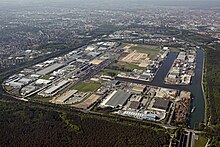
Nuremberg is connected to the national and international waterway network by the Main-Danube Canal on the western edge of the city . In addition to the Bayern port of Nuremberg , the port area in the south of the city is home to the largest freight transport center (GVZ) in southern Germany .
Nuremberg is an important station for river cruises between the Danube and the Rhine, the landing stage was greatly expanded in 2014 and now offers ten berths.
Public facilities
Nuremberg is the seat of the following state authorities and institutions or corporations under public law :
- Bavarian State Ministry of Finance and Homeland (Nuremberg Office)
- Bavarian State Tax Office - Nuremberg Office
- Nuremberg North Tax Office
- Nuremberg South Tax Office
- Central Tax Office Nuremberg
- Federal agency for work
- Federal Office for Migration and Refugees (formerly Federal Office for the Recognition of Foreign Refugees)
- General Customs Directorate - Directorate VI (since 2016, before that until 2007 part of the Oberfinanzdirektion Nürnberg, then until 2015 the seat of the Federal Finance Directorate Southeast)
- Main customs office in Nuremberg
- Institute for labor market and occupational research of the Federal Employment Agency
- Landesgewerbeanstalt Bayern
- Regional Directorate Bavaria of the Federal Employment Agency
- Career center of the Bundeswehr in Nuremberg
- Waterways and Shipping Office for the Danube and Main-Danube Canal
such as:
- Chamber of Crafts Middle Franconia,
- IHK Nuremberg
- Regional Chamber of Architects for Upper and Middle Franconia, KdöR
- Nuremberg Bar Association, KdöR
- Chamber of Tax Advisors Nuremberg, KdöR
- Dental Association, KdöR
- Guild of Precision Engineering Middle Franconia.
There are the following dishes:
- Nuremberg District Court
- District Court Nuremberg-Fürth
- Higher Regional Court of Nuremberg
- Nuremberg Tax Court
- Nuremberg Social Court
- Nuremberg Labor Court
- Regional Labor Court Nuremberg .
public safety
The following institutions are responsible for maintaining public safety and order in Nuremberg:
- Police headquarters in Middle Franconia with eight inspections, a guard, an advice center and four crime departments
- Federal Police Inspection Nuremberg
- Federal Agency for Technical Relief , Nuremberg office and Nuremberg branch
- Professional fire brigade Nuremberg , with five fire and rescue stations
- Nuremberg Volunteer Fire Brigade
- Prison in Nuremberg
The rescue service is provided by the aid organizations Arbeiter-Samariter-Bund (ASB), Bavarian Red Cross (BRK), Johanniter (JUH) and Malteser Hilfsdienst (MHD).
The private company MKT Krankentransport OHG was involved from 1997 to 2018, and RKT Rettungsdienst OHG since 2018 .
Education and Research
Educational institutions
General education schools
The further educational offer in the city area includes 20 grammar schools (public and private) and twelve secondary schools (public and private), five of which are comprehensive schools (public and private), as well as two technical and vocational high schools and numerous vocational, vocational, technical , Middle and elementary schools . The city of Nuremberg runs a pedagogical institute that supports the schools in school development and a school psychological service, which is based in the House of Pedagogy.
Colleges
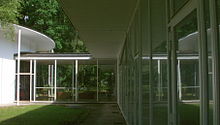
Nuremberg is home to a university, two art colleges, two technical colleges and two study centers for distance learning universities with a total of around 26,000 students in the winter semester (WS) 2018/19.
In May 1526 the St. Egidien grammar school was founded in Nuremberg , from which, after only nine years of operation, the Publica et trivialis schola academy founded by the Nuremberg city council in 1575 and the university in Altdorf near Nuremberg officially emerged in 1622 . With the transfer of Nuremberg in 1806 and Erlangen to Bavaria in 1810 and the newly founded Bavarian state universities, the Altdorfina was closed in 1809 in favor of the Erlangen location .
The Academy of Fine Arts Nuremberg was founded in 1662 by citizens and is the oldest art academy in the German-speaking area. It has resided in buildings designed by Sep Ruf at the Nuremberg zoo since 1954 and has also been home to student teachers since the expansion in 2013. In 2012 the Academy of Fine Arts celebrated its 350th anniversary. In the winter semester 2012/2013 317 students were enrolled.
The Technical University of Nuremberg Georg Simon Ohm was founded in 1971 as a university of applied sciences from several predecessors (oldest 1803) and accommodated 13,054 students in the winter semester 2016/17.
The Nuremberg University of Music, founded in 1998, has been state-owned since 2008 and dates back to a municipal singing school initiated in 1821. She looks after 388 students in the winter semester 2012/13.
Other higher education institutions are the Evangelical University of Nuremberg, founded in 1995 with 1,483 students (WS 2015/16), a regional center of the distance university in Hagen , a location of the FOM University , as well as the second location of the Paracelsus Medical University , opened in 2014 on the grounds of the Nuremberg Clinic .
The Technical University of Nuremberg is also planned to open by 2025 as the tenth Bavarian state university on the former Südbahnhof area for 5,000 to 6,000 students.
In 1918 the Nuremberg University of Economics and Social Sciences was founded as a free university for trade, industry and general public education , approved by the ministry in 1920 and put on an equal footing with other universities in 1925. The concept of the unity of economics and social sciences as the “Nuremberg School” was founded on her. Ludwig Erhard studied, researched and taught here. The university was affiliated to FAU in 1961 as the "Faculty of Economics and Social Sciences" and is located, among other things, on the Maxtor campus.
In 1809 a state school teacher seminar of the Kingdom of Bavaria was set up in Nuremberg, but shortly afterwards it was moved to the vacant building of the former imperial city University of Altdorf. Further establishments followed in Schwabach in 1843, Erlangen and Neuendettelsau. In 1951/54 the Free State of Bavaria decided to academise teacher training and summarized the above under the name "Institute for Teacher Training" in Nuremberg. In 1958 it became the Nuremberg University of Education . In 1972 it was incorporated as the Faculty of Education at FAU, but remained in Nuremberg and is now part of the Faculty of Philosophy as the Faculty of Education.
Around a third of the 39,868 (WS 2016/17) students at FAU are in Nuremberg.
Adult education
The Volkshochschule Nürnberg ( BZ Nürnberg ) offers around 6000 events annually in the areas of society, health, work and career, socially integrative education, culture, languages, planetarium and learning worlds. In addition to the main location on the Gewerbemuseumsplatz, the so-called Südpunkt has also been operated in cooperation with the Office for Culture and Leisure since 2009 .
Libraries and Archives
The Nuremberg City Library is the oldest city library in the German-speaking area and emerged from the council library, which has been verifiable since 1370. It includes the central library on Gewerbemuseumsplatz, several special libraries as well as district and mobile libraries. After the renovation was completed, the music library and the former library in the Pellerhaus on Egidienplatz were merged with the existing facilities to form a modern central library in the Luitpoldhaus. The city library has a total of more than 900,000 items. It also owns around 3,000 manuscripts, 2,100 incunabula and 77,000 old prints.
The University Library Erlangen Nuremberg operates its economic and social science branch library (WSZB) and the educational science branch library (EZB) in the city area. In addition, the library of the Technical University of Nuremberg Georg Simon Ohm offers around 190,000 media and the library of the Germanic National Museum offers around 500,000 media, including 3380 manuscripts and around 1000 incunabula and 3000 prints from the 16th century.
The two important archives in Nuremberg are differentiated according to their sponsorship and are the Nuremberg City Archives and the Nuremberg State Archives .
Research institutions
In the north-east of the city, Nokia (Alcatel-Lucent until 2016) maintains the “Optical Center of Excellence”. A research facility of the Fraunhofer Institute for Integrated Circuits (IIS) is also located on campus .
Nuremberg is a center for labor market and occupational research. The Institute for Employment Research (IAB) and the Research Institute for Company Education (f-bb) work in this area.
In 2009, the Bavarian State Government decided to set up the Energie Campus Nürnberg (EnCN), which will initially be funded with 50 million euros for 5 years. Existing research facilities in the field of energy research at the Friedrich-Alexander-Universität Erlangen-Nürnberg , the Technische Hochschule Nürnberg Georg Simon Ohm , the Fraunhofer Institute for Integrated Circuits , the Fraunhofer Institute for Integrated Systems and Component Technology and the Fraunhofer Institute for Building Physics and the Bavarian Center for Applied Energy Research networked and equipped with research funds. The Energie Campus is located on the former AEG site in the Muggenhof district .
Culture and sights



Museums
Nuremberg is one of the most important museum locations in the German-speaking area and has the most museums per inhabitant of the German cities of millions and half a million . In addition to the museums of the city of Nuremberg , there are some other large museums run by the state or private sponsors, but also smaller museums that primarily deal with Nuremberg customs and history, or other specific subject areas; the following is a selection:
- Albrecht Dürer House , the home of the Nuremberg painter Albrecht Dürer , which primarily provides information about Dürer's life.
- Documentation center Nazi party rally grounds
- Germanisches Nationalmuseum , the largest cultural and historical museum in Germany
- Imperial Castle Museum in Nuremberg Castle
- Children's and youth museum and museum in a suitcase in the tiled building with interactive exhibitions for children and families
- Nuremberg Art Gallery
- Art Association Nuremberg
- Art villa Nuremberg
- Historic dungeons ( under the old town hall )
- Historic tram depot St. Peter , museum with historic trams
- Memorium of the Nuremberg Trials
- Museum of industrial culture
- Neues Museum Nürnberg (State Museum for Art and Design in Nuremberg)
- Toy museum
- City Museum Fembohaus
- tower senses , interactive hands-on museum for perception and hallucinations in a historic city wall tower at the west gate
- Transport Museum Nuremberg , the company museum of Deutsche Bahn and the Museum for Communication , an anchor point of the European Route of Industrial Culture (ERIH)
Memorials
The victims of the Nazi tyranny are commemorated in several places in the city . The Jewish cemetery at Schnieglinger Straße 155 ( Westfriedhof ) contains the graves of 31 concentration camp prisoners , and a commemorative plaque by the monument to the Jewish fallen in World War I commemorates the Jewish citizens who were victims of the Shoah .
A memorial stone in the south cemetery from 1963 preserves the memory of 3,554 Soviet citizens who were victims of concentration camp imprisonment and forced labor .
In 2007, the “Transit” forced labor memorial was inaugurated on Plärrer, commemorating the forced laborers who were deported to Nuremberg during World War II.
On Hans-Sachs-Platz, at the head of the Spitalbrücke, there is a memorial stone to commemorate the vandalized main synagogue and the approximately 1700 Jewish citizens who were stolen from their homes and lives by the Nazi rulers. Something similar can be read on a memorial plaque in the new Jewish community center on Priemstrasse 20 .
In the annex of the Nuremberg justice building at Bärenschanzstrasse 72, in whose jury room 600 the Nuremberg trials took place, the museum "Memorium Nuremberg Trials" has been set up since 2010.
Clubs and associations
Nuremberg has a large number of clubs and associations. Some of them can look back on a long tradition. The best known include:
- Altstadtfreunde Nürnberg e. V.
- Förderverein Kulturhistorisches Museum Nürnberg e. V.
- Lilac e. V., GayLesbian Association
- History for All e. V. - Institute for Regional History
- Kunstverein Nürnberg , Germany's oldest art association
- Natural History Society Nuremberg e. V.
- Pegnese Flower Order e. V.
- Nürnberger Astronomische Arbeitsgemeinschaft e. V., operates the Regiomontanus observatory in Nuremberg
- Franconian Museum Railway e. V. (FME) operates several historic rail vehicles from the Nuremberg Northeast Railway Station, including a. a steam locomotive, and owns the first German large-scale diesel locomotive series V 200 001
Theaters and cinemas
The largest theater in Nuremberg is the State Theater Nuremberg . There are also a few smaller theaters, including:
- Gostner Court Theater
- Art and drama
- Metropolitan Theater Nuremberg
- Nuremberg Burgtheater
- Pocket Opera Company
- Red stage , variety theater and cabaret theater
- Tassilotheater
- Thalia's companions , puppet theater
- Theater salt + pepper
There are a number of children's theaters in Nuremberg:
- Nuremberg Old Town Theater V.
- Theater Mummpitz , children's and youth theater
- Theater roots spoon
- Theater puddle
In addition to the municipal film house in Nuremberg and the Roxy foreign language cinema, there is the Cinecittà Nuremberg (according to its own information, the largest multiplex cinema in Germany), the Admiral cinema and several smaller (program) cinemas. The Nuremberg cinemas counted around two million visitors in 2015.
music
Concert and event halls
- Arena Nürnberger Versicherung (formerly "Arena Nürnberg")
- Frankenhalle
- deer
- Löwensaal Nuremberg
- Serenade Court
- Meistersingerhalle
- State Theater Nuremberg
- K4
- Tafelhalle
- Ruins of the Katharinenkloster
- Z-construction
orchestra
- State Philharmonic Nuremberg ; is the largest Bavarian opera orchestra after the Bavarian State Orchestra.
- Nürnberger Symphoniker , the concert orchestra in the city of Nuremberg, founded in 1946, offers a wide range of different fields of activity: In addition to the symphony and choral concerts and the open-air events in the Serenadenhof , it has a long tradition in the field of film music: Among other things, it took the soundtracks to Ben Hur and Quo vadis and received the 1992 Grammy Award for the recording of Beauty and the Beast . His concerts take place in the Meistersingerhalle.
- Nuremberg Youth Orchestra , the approximately 50-member Nuremberg Youth Orchestra (NJO) was founded in 1985.
- Nuremberg Accordion Orchestra (NAO); The orchestra, founded in 1946, has been one of the most experienced accordion ensembles in Europe for many years.
Chamber ensembles
- ars nova ensemble nürnberg , founded in 1968
- Pegnitzschäfer sound concepts , founded in 1981/82
- ensembleKONTRASTE , founded in 1990
Choirs
- Singin 'Off Beats , mixed jazz choir with band
- JungeChor nürnberg , children's and youth choir of the Nuremberg Music School
- Teachers' Choir Nuremberg, founded in 1878.
- Hans-Sachs-Choir Nürnberg , founded in 1891 as a workers choir "Union" (male choir), mixed choir since 1923; it has about 90 members.
- Bach Choir St. Lorenz ; The choir, which has around 140 members, was founded in 1923 by Lorenz Cantor Walther Körner.
- Philharmonic Choir Nuremberg, founded in 1966.
- Nuremberg Gospel Choir ; the 50-member gospel choir was founded in 1970 and is the oldest of its kind in Nuremberg.
- Sebalder Kantorei
- Egidienchor Nuremberg
- Chamber Choir Nuremberg
- Nuremberg baker's trombones
- Eastern Church Choir Nuremberg of the Evangelical Lutheran Dean's Office, Russian and Ukrainian Orthodox church music in Church Slavonic and German
Clubs and organizations
The year of the event
Regular events
The old town with its history is the site of numerous events. City (“seduction”) tours offer locals and tourists the opportunity to rediscover Nuremberg. Experts, celebrities and city guides offer numerous guided tours within a framework program under an annually changing theme. The Blue Night has been taking place annually since 2000 with a changing focus and invites you to get to know the numerous museums and cultural institutions from early evening to morning with numerous presentations and performances . The old town shines in a blue light that night. In December, the famous Nuremberg Christkindlesmarkt on the main market attracts visitors from all over the world. At this time, the numerous friendly and partner cities also present themselves on the Rathausplatz.
In addition, Nuremberg is home to numerous music festivals in a wide variety of musical styles. The Nuremberg Bardentreffen is the largest world music and songwriter festival in the world on the first weekend of the school summer holidays with 200,000 visitors. Around 160,000 visitors come to the free Klassik Open Air every year , where the Nuremberg Symphony Orchestra and the Nuremberg Philharmonic Orchestra perform on two evenings in a relaxed picnic atmosphere at the Luitpoldhain . Since 1997, internationally known rock and pop music artists have been performing at Rock im Park in front of around 70,000 visitors in the Dutzendteich park . Together with Rock am Ring , it is the largest festival of its kind in Germany. The bridge festival on the Pegnitzgrund under the Theodor-Heuss-Brücke offers numerous free-entry performances outside of the mainstream and with the International Organ Week Nuremberg , Nuremberg is host to what is probably the largest and oldest festival for sacred music and organ music. With the Cloud Sieben Festival and Summer Love Festival , which has been taking place since 2012 and 2014, and the Container Love Festival , which was first held in 2017 , events in the field of electronic music with up to 15,000 participants are also part of the cultural offer. The Opera Ball takes place annually in the Opera House of the State Theater in Nuremberg .
The Turkish-German Film Festival is an important intercultural event as it also receives international attention. There is also the international human rights film festival. The Nuremberg Authors' Talks on current and contemporary issues in the context of the city's historical role last took place in 2005. Since 2003, the Nuremberg / Erlangen / Fürth region, together with universities and innovative companies, has been inviting people to the Long Night of Science every two years .
The cycle race around Nuremberg's old town is a one-day race for amateurs and professionals with its supporting program along the city wall and is a magnet for spectators. The Nuremberg city run is just as popular . Every year around 7,000 recreational athletes start on its route in the southern old town and along Lake Wöhrder. In addition, a DTM race is held annually at the Norisring . In 2006, over 150,000 visitors came to the race, which is organized by the Nuremberg Motorsport Club.
The Nuremberg Volksfest was created on August 25, 1826, similar to the Munich Oktoberfest in honor of the Bavarian King Ludwig I. Since 1919, the spring festival has been held in parallel in the first half of the year. With their attractions and beer tents, the festivals each attract around 1.6 million visitors. In autumn there is the old town festival with stalls on the main market and the festival rooms and tents on Hans-Sachs-Platz and on the island of Schütt. The old town festival opens with the traditional jousting, which has been a custom game since the Middle Ages and in which two teams compete to push each other off small boats on the Pegnitz . The old town festival takes up the traditional patronage festival of St. Egidius, which was celebrated from the late Middle Ages until the 19th century. In its current form it has been held since 1975/1984 and has over a million visitors. The jousting was brought back to life in 1964 by the well-known carnivalist Bromig and city councilor Horst Volk. It has been held annually at the Nuremberg Old Town Festival since 1970. The now deceased former city councilor Horst Volk was also the main initiator of the new edition and rediscovery of the old town festival.
A highlight of the Franconian festival culture is the parish fair (East Franconian "Kärwa"), which takes place at different times depending on the district or village. The traditional form of the village church fair has been preserved not only in the Nuremberg area, but also in villages (for example Neunhof or Großgründlach ) in the Knoblauchsland . The Johanniskirchweih in the St. Johannis district is also known .
nightlife
Bars and discos
In Nuremberg's old town there are pubs and bars and smaller dance halls, especially below the castle, in the area around Weißgerbergasse, along the Pegnitz and in the area around Königsstraße. Larger discos and clubs are usually outside the old town. The music genres rock, pop and hip-hop are played in a discotheque center in and around the former United Margarinewerke RESI building on Klingenhofstrasse. Rather apart from the mainstream, people meet in the cultural centers on Frankenstrasse and in the discos and clubs on Vogelweiherstrasse, where the famous techno club Die Rakete is located. The program in the Künstlerhaus and the various cultural shops in the districts also enrich the evening offer. There is a renowned jazz club on Paniersplatz. More upscale restaurants can be found at the Weinmarkt and near the Germanic National Museum. There are also alternative cultural centers as well as pubs and bars in the Gostenhof and St. Johannis districts .
Red light district
Behind the western end of the Frauentormauer , between Spittler- and Färbertor, as well as Ottostraße and Engelhardsgasse is the central Nuremberg red light district . It is one of the largest of its kind in Germany. First sources point to the practice of prostitution in women's shelters since 1381 . In the 19th century the houses were often referred to as wine shops.
Binge drinking
Since 2007, the city has faced the increasing problem of alcohol excesses , especially among young people, in the Marienbergpark in the area of Marienbucks and Marienbergsee as well as on the Pegnitzgrund with increased controls and in the Kohlenhof area ( flat-rate parties in local discos) with a ban, the latter apparently with A role model for other large cities too.
Night traffic
The public transport company VAG offers a night bus service , the so-called NightLiner, on the nights before Saturday and Sunday as well as public holidays and bridge days , which opens up the entire region and whose lines depart from the main station every hour.
Green spaces and recreational areas
The city is enclosed in the east by the Reichswald , which the Pegnitz divides into a northern “ Sebalder ” and a southern “ Lorenzer ” half. The Reichswald serves as an extensive recreational area as well as fresh air and water reservoir and, as the largest cultural forest in Europe with its 25,000 hectares, has been a protected forest since 1979 . The high level of coniferous wood goes back to the introduction of forest seeds by the Nuremberg councilor Peter Stromer in 1343.
Today attempts are being made to continuously increase the proportion of hardwood. The Schmausenbuck borders the Lorenzer Reichswald as a popular excursion destination, which at 390 m is one of the highest points in the city, used to serve as a sandstone quarry and since 1939 has been home to the then newly created Nuremberg Zoo . The Irrhain lies on the edge of the Sebalder Reichwald near Kraftshof . It was created by pastor Martin Limburger and the baroque poets' association Pegnesischer Blumenorden as a "symbol of the mire forest". The Moritzberg , whose place of the same name now officially belongs to Röthenbach and is located in the Lorenzer Reichswald, with its 598 meters is considered the local mountain of Nuremberg and, along with the Franconian Moritzbergkirchweih on the Sunday before Bartholomew's Day, is a year-round attraction when the weather is nice.

In addition, there are artistic and historically significant gardens of the baroque palace gardens of Neunhof , the Hesperides gardens in St. Johannis and the so-called mayor's garden as well as the castle garden on the bastions of the city fortifications next to the imperial castle. Other smaller parks are the archive park near Friedrich-Ebert-Platz, framed by buildings from the Wilhelminian era and Art Nouveau, the Cramer-Klett-Park with its classicist garden buildings, the intensively used Rosenaupark near the Plärrer, the Südstadtpark and the Platnersberg and the Rechenberg in the east of the city. In the old town, the banks of the Pegnitz always invite you to relax. This forms east of the old town ring, whose city wall moat is also greened like a park, next to the Wöhrder meadow the dammed Wöhrder See . There are popular beer gardens as well as the field of experience for developing the senses .
The Dutzendteich (from doze for reed) is a lake that was dammed up around 1430 in a southeast direction from the center. It served as a fish pond and was already in the 16./17. Century a popular destination. Together with the adjacent Luitpoldhain , it was used in 1906 as an area for the Bavarian state commercial industry and art exhibition under Prince Regent Luitpold. After 1933, during the Nazi era, the area was redesigned into a Nazi party rally grounds and, above all, the Dutzendteich was considerably reduced in size. Even if it is partly unclear how one should deal with the area that was created during the Nazi era in addition to a museum and warning use, the Dutzendteich park is again a popular local recreation area.
The Nuremberg garden director Alfred Hensel, who had planned the 100 hectare Volkspark am Dutzendteich and also sports and playgrounds, the redesign of the Luitpoldarena and the landscaping of the 60 hectare Nuremberg zoo, was given the task of creating an integrated green space system for the city and to develop surrounding areas. A coherent area was created with a length of 20 km, which included existing green spaces and created pedestrian connections.
In addition, in the postwar period from 1959 to 1973 in the area of the former airport in developed brick of Marienberg Park in the style of an English landscape park. Another Volkspark was built between 1970 and 1981 with the Westpark (11 ha) in the St. Leonhard district . The city park was laid out on the Maxfeld after the first Bavarian state exhibition in 1882. Today the Neptune Fountain is also set up there. On the outskirts in the Röthenbach district are the extensive Faber Park (25 hectares) and in the Gebersdorf district part of the Hainberg nature reserve with its rare sandy grass areas that are worth protecting. See also List of Nature Reserves in the City of Nuremberg and List of Landscape Protection Areas in the City of Nuremberg .
In the urban area there are three nature reserves, 19 landscape protection areas, 39 protected landscape components and 96 natural monuments . With the exception of the extensive Holsteinbruch natural monument, the natural monuments are individual trees, rows of trees and avenues.
In the region, Franconian Switzerland in the north with its climbing opportunities, Hersbrucker Schweiz in the east with its hiking trails and the waters of the Franconian Lake District and the Altmühl in the south offer numerous opportunities for active sports around the city.
Sports
Origins of sport in Nuremberg
Since the 14th century, sport-like communities of riflemen and fencers have emerged in Nuremberg . In 1434 the council set up a sports, play, festival and shooting ground on Hallerwiese, which is considered the oldest in Germany. In 1628 the fencing house was built on the rear island of Schütt .
The history of modern sport in Nuremberg did not begin until the middle of the 19th century. In 1846 the gymnastics movement was organized for the first time in the gymnastics and sports club 1846 Nuremberg. The gymnastics club Gleißhammer was the first South German gymnastics club, which in 1893 broke with the bourgeois gymnastics movement and joined the newly formed social democratic workers' sports movement. Within a very short time, Nuremberg developed into the center of workers' sport in southern Germany.
Development into a sports stronghold

The dominance of Nuremberg workers' sports clubs in the 1920s and early 1930s was part of Nuremberg's development into a sports stronghold. The importance of Nuremberg football was a second important component. The 1. FC Nürnberg (FCN) was the most successful German football club this time and won six times from 1920 to 1936, the German Cup . With nine championship titles, the FCN is still vice-record champion. At times, players from 1. FC Nürnberg made up half of the players in the German national soccer team . In the 1920s, the city built the municipal stadium (currently: Max-Morlock-Stadion), a modern sports facility with a cinder track and an attached swimming pool.
The reputation as a sports stronghold was supplemented by the successes of Nuremberg clubs in weight training , wrestling and especially in cycling . Between 1890 and 1900 alone, 52 cycling clubs were founded. The first cycling track in Bavaria was built in Nuremberg, and the Reichelsdorfer Keller cycling track, which still exists today, was opened in 1912. The standing races were particularly popular.
After the Second World War, Nuremberg was only able to maintain its reputation as a sports stronghold in the 1950s and 1960s. In cycling and athletics, Nuremberg produced a few outstanding athletes. In handball , the women of 1. FC Nürnberg dominated in the 1960s. With the descent of the soccer team of 1. FC Nürnberg in 1969, immediately after the German soccer championship was won for the last time in 1968, a change took place in the sport of Nuremberg.
The Nuremberg Marathon took place at irregular intervals from the late 1970s to 2005 .
Competitive sport crisis
Only marginal sports such as fistball at the gymnastics club Eibach 1903 or wrestling at SV St. Johannis 07 for Olympic champion Pasquale Passarelli were still successful nationally and internationally . Many sports clubs withdrew from competitive sports and devoted themselves to popular sports . In this way, Post SV Nürnberg became the German sports club with the largest number of members in the 1980s and in 2006 is still the second largest sports club in Bavaria. Attempts to establish other competitive sports in addition to football ended with the clubs' financial collapse. The gymnastics and sports club 1888 Nürnberg had to withdraw from the 2nd Bundesliga handball league in 1990 after having been promoted to the 1st Bundesliga several times in the 1980s.
Return to top sport
In the 1990s and since the turn of the millennium, however, Nuremberg clubs managed to work successfully in all popular team sports. For example, the men's soccer department of 1. FC Nürnberg returned to the 1. Bundesliga after relegating to the third division. After 39 years without a title, the club won the DFB Cup in 2007 and played internationally for the first time in 19 years. The handball women of 1. FC Nürnberg were able to build on their successful time in the 1960s and last won the German championship in 2008. In American football , the Nürnberg Rams played in the 1st Bundesliga from 1983 to 1998 and won the championship in the southern group in 1987, 1989, 1991 and 1996. In ice hockey , the Nürnberg Ice Tigers were able to establish themselves as a top club in the top division . In 1999 and 2007 the Ice Tigers became German vice-champions. In order to create a permanent basis for a club in the top ice hockey league, the Nürnberger Versicherung Arena, which can hold up to 11,000 spectators, was opened in February 2001 . In this multifunctional arena, the Sellbytel Baskets Nürnberg played from 2005 to 2007 , which at that time belonged to the basketball league . The arena was also used by the Brose Baskets from Bamberg to host the games in the ULEB Euroleague before they expanded their own arena. In Nuremberg there after the end of hawk nor the Nürnberger BC in the second Bundesliga Pro A . HTC from Nuremberg has been represented in the field hockey Bundesliga since 2007 . In the indoor hockey Bundesliga , Nuremberg was even represented with two clubs. From 2007 to 2009 the HG Nürnberg played first class, the Nuremberg HTC has been represented in the first division since 2008. The men of the 1. FC Nürnberg tennis club were back in the Bundesliga from 2005 to 2007. At the beginning of 2006, the SV St. Johannis 07 wrestling squad returned to the 1st Bundesliga, to which they belonged until the end of 2008. Nuremberg's return to the ranks of sports strongholds was underpinned in 2004 with the establishment of the German Academy for Football Culture , which has since occupied the space between the sporting aspect of football and the features section.
Within the TSC (Tanz-Sport-Club) Rot-Gold-Casino e. V. Nuremberg there is a small but very successful wheelchair dance department . One of the couples (Claudia Maierl and Christian Feeß) represents the association on the national and international stage. It is German champion of the class LWD1 2005, 2006, 2008 and 2009. One of the standard formations of the TSC Rot-Gold-Casino Nürnberg has a standard formation, which dances in the 1st Bundesliga. One of the Latin formations also based there is dancing in the 2nd Bundesliga.
An international tennis tournament has been held in Nuremberg since 2013 with the WTA Nuremberg .
sports clubs
- The 1. FC Nuremberg is currently the largest sports club in the city, the Post SV Nuremberg is the largest pure sports club just behind this.
Alpine sports
The Nuremberg Sections of the German Alpine Club are: Section Nuremberg (11,157 members, founded 14 December 1869), Section Noris (2,669 members, founded in 1904), Section Frankenland (760 members, founded in 1904), Section Gipfelstürmer 08 (198 members, founded in 1908 ), Section German Ski Club Nuremberg (8 members, founded in 1938). These maintain refuges in the Alps and other mountains, as well as some climbing facilities and high-altitude trails , the "Noris Section", the Norissteig and the Höhenglücksteig .
Regional specialities
As early as the years between 1302 and 1310, the city council issued an order to brew exclusively with barley. Although the bottom-fermented, heavily hopped red beer was most common in Nuremberg for a long time , it is almost unknown today. Wheat beer has also been brewed since 1531. But wine was also a valued drink. The rocky passages point to the great importance of the art of brewing in Nuremberg. In 1880, Nuremberg was at the forefront of Bavarian beer exports with a volume of 173,000 hectoliters. Today only a few breweries remain in the city itself, but the region still has a high density of breweries. These microbreweries enjoy an excellent reputation. The Spalter beer , brewed with the hops grown there, is also known and valued .
The city's most famous sausage specialty is the Nuremberg Rostbratwurst . As early as 1497, the city council prescribed ingredients and size. The small size of only seven to nine centimeters seems to have been an expression of the high prices in Nuremberg at the time of the Middle Ages. But this is the secret of their taste, along with the typical marjoram note, as the beech fire's grill aroma is better accepted due to the favorable ratio of surface and volume. It is eaten either in a roll ( East Franconian-Nuremberg "Weggla") with mustard or with boiled sauerkraut , but then - preferred by the locals - with horseradish, called horseradish in East Franconia. The Nuremberg sausages cooked in a vinegar stock with onions are called Sauere Zipfel .
The city sausage is also a valued sausage specialty in Nuremberg. As the “city sausage with music”, it is served in numerous beer gardens in summer, thinly sliced on a plate, with finely chopped onions, a mildly sour vinegar dressing and a few slices of wood-fired bread. The ox mouth salad also has a slightly sour, refreshing taste, it becomes a Nuremberg gwerch with additional ingredients .
As freshwater fish, the carp is baked or eaten blue from the traditional cuisine of the city and the region. A typical Sunday roast is the Schäuferle with raw dumplings . In addition, the Franconian sauerbraten , whose sauce is refined with a sauce gingerbread, is valued.
The traditional use of a large number of spices can be traced back to the extensive long-distance trade in the Middle Ages. The nationally known Nuremberg gingerbread also represents this wealth of flavors. Its production in the city has been documented since the 13th century. Knee cakes are traditionally baked for the parish fair in summer .
Personalities
Albrecht Dürer
painterWillibald Pirckheimer humanist
Hans Sachs
poetJohann Pachelbel composer
Ludwig Feuerbach philosopher
Sigmund Schuckert inventor
Konrad Feuerlein hymn composer
Well-known personalities such as Albrecht Dürer (painter), Martin Behaim (inventor of the first globe), Hans Sachs (poet), Peter Henlein (alleged inventor of the pocket watch ), Johann Benjamin Erhard (philosopher), Anton Koberger (printer and dealer ) come from Nuremberg ), Veit Stoss (sculptor, carver), Adam Kraft (sculptor), Georg Philipp Harsdörffer (poet), Johann Pachelbel (composer), Karl Hegel (historian), Sigmund Schuckert (inventor and industrialist), Theodor von Cramer-Klett (company founder ), Max Grundig (company founder), Hugo Distler (composer), Theo Schöller (entrepreneur), Hermann Zapf (typographer), Hildegund Holzheid (former President of the Bavarian Constitutional Court), Günther Beckstein (former Bavarian Prime Minister) and Markus Söder (incumbent Bavarian Prime Minister ). In addition, the city was also a center of attraction and part of the life of many well-known people, such as Georg Wilhelm Friedrich Hegel (philosopher) and Ludwig Feuerbach (philosopher).
Sagas, legends and anecdotes
Tomb of Saint Sebaldus
Grave of the Kunigunde of Orlamünde
Till Eulenspiegel annoys the Nuremberg city guards
Eppelein's jump over the castle wall
The Nuremberg funnel
Many places in the city are associated with legends, such as the castle wall, over which Eppelein von Gailingen jumped with his horse, according to legend. The city patron St. Sebaldus not only worked numerous miracles, but also allegedly did not want to rest until the Sebalduskirche was built. Kunigunde von Orlamünde murdered her two children after misunderstanding a statement made by the beloved Burgrave of Nuremberg, repented and founded the former Himmelthron monastery outside the city walls in what is now the Großgründlach district. After her death, as a white woman, she warns of misfortune. Kaspar Hauser appeared on Unschlittplatz in 1828 , who aroused great interest as a mysterious foundling. Schwänke like Till Eulenspiegel also name and sometimes play in specific locations in the city. Also known is the Nuremberg funnel , an allegory often jokingly interpreted for a mechanical understanding of learning, according to which knowledge can be instilled without the need for willingness to learn or talent.
useful information

On the last series of D-Mark banknotes , on the 500 D-Mark banknote, to the left of the portrait of the naturalist Maria Sibylla Merian , there was a collage of various historical buildings in Nuremberg. There you can see the Imperial Castle with Sinwell Tower and Imperial Stables , the Sebaldus Church , the Frauenkirche , the Albrecht-Dürer-Haus , the Fembohaus , the Nassauer Haus , the Weinstadel , the Heilig-Geist-Spital , the Mauthalle , the Lorenzkirche and the city fortifications .
Nuremberg was the inspiration for a number of literary and musical works. These include the opera Die Meistersinger von Nürnberg by Richard Wagner , Adolphe Adams opera La poupée de Nuremberg ( The Nuremberg Doll ), as well as Alexandre Dumas ' story Histoire d'un casse-noisette ( The story of a nutcracker ), which is written by Pjotr Ilyich Tchaikovsky was set to music for the famous ballet .
The main belt asteroid (3825) Nuremberg , discovered by Luboš Kohoutek on October 30, 1967 , was named after the city.
Conrad Stör, the former innkeeper "Zum golden Ochsen" (today at Unteren Markt 16), opened the first Nuremberg coffee house in 1696 together with the confectioner Georg Albrecht at the former Fünferplatz 6 ("Haus zum Frosch") , which Conrad Stör opened until around 1730 and then led his widow. The café , later called the “old coffee house”, was the only one in Nuremberg for 62 years (the “Zur Rose” inn, later Café Noris, was licensed to serve hot drinks in 1758).
See also
literature
reference books
- Rudolf Endres , Michael Diefenbacher (Hrsg.): Stadtlexikon Nürnberg. Tümmel, Nürnberg 1999, ISBN 3-921590-69-8 (2nd, improved edition 2000 with the same ISBN, online version of the city archive ).
- Franz Schiermeier (Ed.): City Atlas Nuremberg. Maps and models from 1492 to the present day. Schiermeier, Munich 2006, ISBN 978-3-9809147-7-2 .
- Wolfgang Baumann (ed.), Hajo Dietz: The Nuremberg Atlas. Diversity and change of the city on the map. Emons, Cologne 2007, ISBN 978-3-89705-533-9 .
Statistical yearbook
- Office for urban research and statistics for Nuremberg and Fürth (ed.): Statistical year book of the city of Nuremberg. , Nuremberg 1909–1940 (1935–1940 as the statistical yearbook of the city of the Nuremberg Rally , 1941–1963 no yearbooks were published, 1964–1975 as Nuremberg in numbers ), ISSN 0944-1514 , digital copies of all volumes on nuernberg.de
history
-
Historical commission at the Bavarian Academy of Sciences (Ed.): Nuremberg. in 5 volumes (= The Chronicles of German Cities ), Hirzel, Leipzig 1862–1874; Digital copies of the Bavarian State Library :
- Volume 1, urn : nbn: de: bvb: 12-bsb10800624-0
- Volume 2, urn : nbn: de: bvb: 12-bsb10800625-5
- Volume 3, urn : nbn: de: bvb: 12-bsb10800629-2
- Volume 4, urn : nbn: de: bvb: 12-bsb11007304-6
- Volume 5, urn : nbn: de: bvb: 12-bsb11184637-2
- Johann Kaspar Bundschuh : Nuremberg . In: Geographical Statistical-Topographical Lexicon of Franconia . tape 4 : Ni-R . Verlag der Stettinische Buchhandlung, Ulm 1801, DNB 790364301 , OCLC 833753101 , Sp. 94-145 ( digitized version ).
- Herbert Erlanger: Nuremberg Medals 1806–1981. The "metal chronicle" of the former imperial city in the age of industrial culture. Scientific supplements to the display of the Germanisches Nationalmuseum, Nuremberg 1985.
- Joachim Gruber : Nürnberg In: Manfred Landfester (Hrsg.): Renaissance-Humanismus: Lexikon zur Antikerezeption (= Der Neue Pauly. Supplements. Volume 9), Metzler, Stuttgart 2014, ISBN 978-3-476-02469-5 , Sp. 699 f. (Licensed edition Wissenschaftliche Buchgesellschaft, Darmstadt 2014, ISBN 978-3-534-18509-2 ).
- Gerhard Gruner: Nuremberg in years. Nuremberg 1999.
- Hanns Hubert Hofmann : Nuremberg-Fürth (= Historical Atlas of Bavaria, part Franconia I, 4). Commission for Bavarian State History, Munich 1954, DNB 452071224 ( digitized version ).
- Matthias Kirchhoff: Memory in Nuremberg texts of the 15th century: memorial books, books of brothers, city praise, chronicles (= Nuremberg workpieces on city and state history. Volume 68). Schmidt, Neustadt an der Aisch 2009, ISBN 978-3-87707-773-3 , DNB 999597396/04 Table of contents.
- Eugen Kusch: Nuremberg. City life image. Verlag Nürnberger Presse, Nuremberg 1950 (5th, complete and updated edition. ISBN 3-920701-79-8 , DNB 900563028/04 table of contents).
- Gerhard Pfeiffer (Hrsg.): Nuremberg, history of a European city. CH Beck Verlag, Munich 1971, ISBN 3-406-03394-6 (unmodified reprint 1982, ISBN 3-406-08764-7 ).
- Johann Paul Priem : History of the City of Nuremberg. Jakob Zeiser Verlag, Nuremberg 1875.
- Martin Schieber: Nuremberg. An illustrated history of the city. CH Beck Verlag, Munich 2000, ISBN 3-406-46126-3 .
- Pleikard Joseph Stumpf : Nuremberg . In: Bavaria: a geographical-statistical-historical handbook of the kingdom; for the Bavarian people . Second part. Munich 1853, p. 675-680 ( digitized version ).
- Friedrich Wilhelm Ghillany : Nuremberg historically and topographically according to the oldest existing sources and documents. Georg Franz, Munich 1863 ( preview in Google book search).
- Georg Wolfgang Karl Lochner : The population of the former imperial city of Nuremberg. J. Ludw. Schmid, Nürnberg 1857 ( preview in Google book search).
Siegelkunde (Sphragistik) and Heraldry (Heraldry)
- Reinhold Schaffer: The seal and coat of arms of the imperial city of Nuremberg. In: Journal for Bavarian State History . Volume 10, 1937, p. 157 f. ( Digitized version of the Bavarian State Library ).
Judaism
- Arnd Müller: History of the Jews in Nuremberg. 1146–1945 (= contributions to the history and culture of the city of Nuremberg. Volume 12). City Library, Nuremberg 1968 (with bibliography, pp. 348–356).
Economic history
- Quasi centrum Europae: Europe buys in Nuremberg; 1400-1800; Germanisches Nationalmuseum, Nuremberg, June 20 to October 6, 2002. Publishing house of the Germanisches Nationalmuseum, Germanisches Nationalmuseum, Nuremberg 2002, ISBN 3-926982-88-8 , DNB 964523841/04 Table of contents.
- Wolfgang Mayer, Frank Thyroff: Between pepper and high-tech. A journey through Nuremberg's economic history. Fahner Verlag, Lauf 2014, ISBN 978-3-942251-13-6 , DNB 1046519441/04 Table of contents.
Traffic history
- Ferdinand von Rüden (Ed.): Transport node Nuremberg. From the beginning until the seventies. Ek-Verlag, Freiburg im Breisgau 2010, ISBN 978-3-88255-248-5 , DNB 997539135/04 Table of contents, content text (additional DVD: Transport node Nürnberg. Einst & Jetzt. EK-Verlag, Freiburg im Breisgau 2013, DNB 1026816238 , Content text ).
Health Care History
- Ernst Mummenhoff : On the history of the epidemic houses. Festschrift for the 65th Assembly of German Naturalists and Doctors. Nuremberg 1898.
National Socialism
- Eckart Dietzfelbinger, Gerhard Liedtke: Nuremberg - place of the masses: the Nazi party rally grounds - prehistory and difficult legacy. Christoph Links Verlag, Berlin 2004, ISBN 3-86153-322-7 , DNB 969956711/04 Table of contents (Licensed edition Weltbild, Augsburg 2008, ISBN 978-3-8289-0846-8 ).
History magazines
- Announcements from the Association for the History of the City of Nuremberg. Self-published or Schrag, Nuremberg 1879–1944 and since 1949, ISSN 0083-5579 ( digital copies of the Bavarian State Library ).
Art and architecture
- Helmut Beer: Nuremberg memories. The city before the destruction in color photographs (= Nuremberg memories. Volume 14). 2nd Edition. Nuremberg 2005.
- Günther P. Fehring , Anton Ress , Wilhelm Schwemmer: The city of Nuremberg (= Bavarian art monuments . Volume 10 ). 2nd Edition. Deutscher Kunstverlag, Munich 1977, ISBN 3-422-00550-1 .
- Werner Schultheiß, Ernst Eichhorn: Nuremberg. The beauty of the Noris (= Pirkheimerianum. Volume 16). Glock and Lutz, Nuremberg 1957 (3rd, expanded and redesigned edition: Nuremberg. Dürerstadt, Florenz des Nordens. 1971).
- Wilhelm Schwemmer: The community center in Nuremberg (= The German community center. Volume 16). Wasmuth, Tübingen 1972, ISBN 3-8030-0018-1 , DNB 720204518/04 Table of contents.
- Wilhelm Schwemmer: Old Nuremberg mansions, the council fortified open houses (= Bavaria antiqua. Hidden treasures of Bavarian cultural history ). Bayerische Vereinsbank, central department ÖAV, Public Relations Office, Munich 1979.
International Relations
- Norbert Schürgers: Nuremberg international. Information on the international relations of the city of Nuremberg. Office for International Relations, Nuremberg 2010 (4th, revised and expanded edition, 2014 ( online at nuernberg.de ) [PDF; 3.7 MB]).
Magazines in general
- Nuremberg today. Magazine for everyone who likes Nuremberg. A half-yearly publication. Press and Information Office, Nuremberg since 1964 ( online edition on nuernberg.de , archive of the numbers since 2003 on nuernberg.de ).
Maps and plans
- Max Bach : Historical plan of the former imperial city of Nuremberg. E. Nister's Kunstanstalt, Nuremberg 1882 ( digitized version of the Bavarian State Library ).
Web links
- Literature from and about Nuremberg in the catalog of the German National Library
- Entry on the coat of arms of Nuremberg in the database of the House of Bavarian History
- Michael Diefenbacher: Nuremberg, Imperial City: Political and Social Development . In: Historical Lexicon of Bavaria
- Michael Diefenbacher: Nuremberg, imperial city: territory . In: Historical Lexicon of Bavaria
- Michael Diefenbacher: Nuremberg patrician . In: Historical Lexicon of Bavaria
- Jürgen Küster: Nuremberg Schembartlauf . In: Historical Lexicon of Bavaria
- Timeline - Israelitische Kultusgemeinde Kdö.R. (History of the Nuremberg Jews)
- History of the Jews in Nuremberg and Fürth by Hugo Barbeck, Verlag Friedrich Heerdegen (Barbeck), 1878, free download
- Official website of the city of Nuremberg
- Antifascist Chronicle for Nuremberg. In: loester.net. Rüdiger Löster (private website)
- Basic planning for the landscape order of the Nuremberg area, year 1943 on the portal 100 years landscape architecture from the bdla
- Nuremberg: Official statistics of the LfStat
References and comments
- [SL] Michael Diefenbacher , Rudolf Endres (Hrsg.): Stadtlexikon Nürnberg . 2nd, improved edition. W. Tümmels Verlag, Nuremberg 2000, ISBN 3-921590-69-8 ( online ).
- ^ Herbert Maas: Noris .
- ↑ Charlotte Bühl: Islamic Communities .
- ^ Bernhard Purin : Synagogues . S. 1060 .
- ^ Maximilian Rosner: pedestrian zone .
- ^ Robert Fritzsch: City Library . S. 1018 f .
- ^ Herbert Maas: Fischerstechen . S. 288 .
- ^ Charlotte Bühl, Herbert Maas: Old Town Festival . S. 66 .
- ^ A b Peter Fleischmann: Reichswald . S. 878 f .
- ^ Hermann Rusam: Irrhain . S. 480 f .
- ^ Wiltrud Fischer-Pache: Moritzberg . S. 701 .
- ↑ Michael Diefenbacher : Dutzendteich . S. 701 .
- ^ Helmut Beer: City Park . S. 1022 .
- ^ A b c Gunther Friedrich: Brewing . S. 158 f .
- ^ Helmut Beer: Beer taverns . S. 144 .
- ↑ Herbert Maas: Gingerbread . S. 617 f .
- Other sources
- ↑ "Data 2" sheet, Statistical Report A1200C 202041 Population of the municipalities, districts and administrative districts 1st quarter 2020 (population based on the 2011 census) ( help ).
- ↑ Herbert Maas: mouse Gesees and ox leg . Small north Bavarian place-name studies. 3. Edition. Nuremberg 1995, p. 160 f .
-
^ Wolf-Armin von Reitzenstein : Lexicon of Franconian place names. Origin and meaning . Upper Franconia, Middle Franconia, Lower Franconia. CH Beck, Munich 2009, ISBN 978-3-406-59131-0 , p. 164 f . ( limited preview in Google Book search). Cf. Alfred Bammesberger: Further considerations on the name of the city of Nuremberg . In: Communications from the Association for the History of the City of Nuremberg . tape
87 , 2000 ( (digitized) ). - ↑ Herbert Maas: Is Nuremberg the "Castle of Noro" or the castle on the Felsberg? In: Communications from the Association for the History of the City of Nuremberg . tape 77 , 1990, pp. 1–16 ( digitized version ).
- ↑ a b Statute on the use of the city arms (StadtwappenS - StWS) (PDF; 131 kB) of April 25, 2002 (Official Journal p. 265). In: nuernberg.de, accessed on June 7, 2020.
- ↑ a b designtagebuch.de: New appearance.
- ↑ wirdesign.de ( Memento of 13 December 2011 at the Internet Archive )
- ↑ Statistical Yearbook of the City of Nuremberg 2013, Chapter 18 (PDF; 7.9 MB)
- ↑ Since the German Meteorological Service began recording at Nuremberg Airport in 1955, the maximum temperature ( memento from September 23, 2015 in the Internet Archive ) (PDF; 64 kB) on July 27, 1983 was 38.6 ° C.
- ^ Climate Nuremberg, Middle Franconia , German Weather Service, on wetterdienst.de
- ^ Walter Jungkunz: The mortality in Nuremberg 1714-1850, at the same time a contribution to the epidemic history of the city. In: Communications from the Association for the History of the City of Nuremberg. Volume 42, 1951, pp. 289-352, here: p. 324.
- ↑ Manfred Vasold: The mortality in Nuremberg in the 19th century. Living conditions, illness and death (around 1800 to 1913). In: Würzburg medical history reports. Volume 25, 2006, pp. 241-338, here: pp. 290 f.
- ↑ Section 3.1.5. (PDF; 3.1 MB) (No longer available online.) In: Yearbook Nuremberg 2009. City of Nuremberg, Office for Urban Research and Statistics, January 2010, p. 35 , archived from the original on January 24, 2011 ; accessed on December 8, 2010 (only main residences and after comparison with the other state offices).
- ^ Special report S234: New population figures for Nuremberg and Fürth. May 31, 2013 ( nuernberg.de [PDF; 519 kB]).
- ^ City of Nuremberg / Online Office: Monthly Reports 2015 to 2019 - Urban Research and Statistics for Nuremberg and Fürth. Retrieved on March 8, 2018 ( monthly report December 2015. 2015 annual review for Nuremberg and Fürth - part 1 ).
- ↑ © Bavarian State Office for Statistics, Fürth 2017: Bavarian State Office for Statistics - GENESIS-Online Bavaria. March 15, 2019, accessed March 15, 2019 .
- ^ City of Nuremberg / Online Office: Monthly Reports 2015 to 2019 - Urban Research and Statistics for Nuremberg and Fürth. Retrieved on March 8, 2018 ( monthly report December 2017. Annual review 2017 for Nuremberg and Fürth - part 1 ).
- ^ City of Nuremberg / Online Office: Monthly Reports 2015 to 2019 - Urban Research and Statistics for Nuremberg and Fürth. (PDF; 214 kB) Accessed on March 8, 2018 ( monthly report December 2018. 2018 annual review for Nuremberg and Fürth - part 1 ).
- ↑ Nuremberg as a business location. Positioning 2019. Accessed July 19, 2020 .
- ↑ a b c d Friedrich Wilhelm Ghillany : Nuremberg historically and topographically according to the oldest existing sources and documents. Georg Franz, Munich 1863, p. 99 ( preview in Google book search)
- ^ Georg Wolfgang Karl Lochner : The population of the former imperial city of Nuremberg. J. Ludw. Schmid, Nürnberg 1857, p. 24 ( preview in the Google book search).
- ↑ a b c Nuremberg . In: Meyers Großes Konversations-Lexikon . 6th edition. Volume 14, Bibliographisches Institut, Leipzig / Vienna 1908, pp. 842–845 .
- ↑ Kgl. Statistical Bureau (ed.): Complete list of localities of the Kingdom of Bavaria. According to districts, administrative districts, court districts and municipalities, including parish, school and post office affiliation ... with an alphabetical general register containing the population according to the results of the census of December 1, 1875 . Adolf Ackermann, Munich 1877, 2nd section (population figures from 1871, cattle figures from 1873), Sp. 1141 , urn : nbn: de: bvb: 12-bsb00052489-4 ( digitized version ).
- ↑ a b c d e f g h i j k M. Rademacher: German administrative history from the unification of the empire in 1871 to the reunification in 1990. In: treemagic.org (online material for the dissertation, Osnabrück 2006).
- ↑ a b c Global comparative study evaluating the quality of life in 221 large cities. (No longer available online.) In: mercer.de. Mercer Deutschland GmbH, archived from the original on January 18, 2012 ; accessed on April 4, 2018 .
- ↑ Quality of life: Munich still at the top in Germany. Press release. In: mercer.de. Mercer Deutschland GmbH, March 18, 2018, accessed on March 20, 2018 .
- ↑ Statistical Information System Nuremberg ( Memento from March 3, 2016 in the Internet Archive ).
- ↑ a b c Werner Besch, Anne Betten, Oskar Reichmann, Stefan Sonderegger (eds.): History of language. A handbook on the history of the German language and its research. Volume 3. 2nd edition. Berlin / New York 2003, pp. 2341-2354.
- ^ Josef Pfanner: The German writing language in Nuremberg from its first appearance to the end of the 14th century. In: Communications from the Association for the History of the City of Nuremberg. Volume 45 (1954) ( Digitale-sammlungen.de ).
- ↑ a b c Christoph Plass: Dialects - Nuremberg Maadla, Fürther Maadli. In: sueddeutsche.de . May 11, 2010, accessed December 25, 2014 .
-
↑ The Speaking Language Atlas of Bavaria - here you can listen to several audio documents from the Nuremberg area.
August Heinrich Gebhardt, Otto Bremer: Grammar of the Nuremberg Dialect. (Collection of short grammars of German dialects; Volume 7). Leipzig 1907. - ↑ City of Nuremberg Religion , 2011 census
- ^ City of Nuremberg Population Denomination , accessed on February 22, 2020
- ↑ Statistical figures on religion and population Nuremberg. In: catholic-kirche.stadtkirche-nuernberg.de, accessed July 24, 2020 ("Others" include people of other religions and denominations than Roman Catholic and Evangelical Lutheran as well as people who do not belong to any religious community. ").
- ↑ Persons by religion (in detail) for Nuremberg (district-free city). In: zensus2011.de, accessed on August 15, 2017.
- ↑ Map page: Muslims in Bavaria - communities. In: kartseite.wordpress.com. March 27, 2017, accessed January 13, 2018 .
- ↑ nuernberg-evangelisch.de
- ↑ kirchenkreis-nuernberg.de
- ↑ wls-nbg.de - the home of Wilhelm Lohe School
- ↑ evhn.de - the homepage of the Evang. Nuremberg University of Applied Sciences
- ↑ eckstein-evangelisch.de.
- ↑ evangelische-stadtakademie-nuernberg.de
- ^ Locations of the Diakonie on diakonieneuendettelsau.de
- ↑ Clinics on diakonieneuendettelsau.de
- ↑ Homepage of Diakonie Neuendettelsau
- ↑ About us | Rummelsberger Diakonie. In: rummelsberg.de, accessed on April 26, 2020.
- ↑ a b Population with main residence - religion / denomination (BSDB_04) • Nuremberg • December 31, 2013 ( Memento from February 6, 2016 in the Internet Archive ), Statistical Information System Nuremberg.
- ↑ a b Catholic City Church Nuremberg
- ↑ copgermany.com
- ↑ igrejasevangelicasnaeuropa.blogspot.de
- ↑ ea-nuernberg.de
- ^ Chronicle of the Nuremberg Social Welfare Service, 1990 ( memento from June 30, 2012 in the Internet Archive ) (current figures are not available).
- ↑ Old Catholics Nuremberg
- ↑ a b c d e f g Overview of the religious communities on dasein.nuernberg.de Status: Autumn 2011
- ↑ File: Nuremberg Orthodox Church 4231.jpg .
- ^ Romanian Orthodox Metropolis ( Memento from September 15, 2008 in the Internet Archive )
- ^ The Russian Orthodox Church in Nuremberg
- ↑ Islamic Community Nuremberg e. V. (IGN)
- ↑ Pictures of Nuremberg mosques ( Memento from September 22, 2007 in the Internet Archive ). In: ansary.de, accessed on April 23, 2019.
- ↑ shia-forum.de
- ↑ aleviten-in-nuernberg.de .
-
↑ MGH SS 20, p. 372 cap. 37
Cf. Arnd Müller: History of the Jews in Nuremberg. 1146-1945 . Contributions to the history and culture of the city of Nuremberg. tape 12 . Self-published Nuremberg City Library, Nuremberg 1968, p. 14 . - ↑ Sigmund Meisterlin: Chronicle of the Imperial City of Nuremberg 1488 . In: Matthias Lexer (ed.): The chronicle of the Franconian cities . 3: Nuremberg. S. Hirzel, Leipzig 1864, p. 92 ( preview in the google book search): "This Cunrat and his several frawe Flora always won over to Nurenberg and baweten on the gaßen under sant Egidien with prerent stainen."
- ↑ Cf. Arnd Müller: History of the Jews in Nuremberg. 1146-1945 . Contributions to the history and culture of the city of Nuremberg. tape 12 . Self-published Nuremberg City Library, Nuremberg 1968, p. 15th f .
- ↑ Claudia Frieser, Birgit Friedel: ... the jews hi were sitting in the middle of the square ... The first Nuremberg Jews and their settlement until 1296 . In: Birgit Friedel, Claudia Frieser (Ed.): Nürnberg. Archeology and cultural history. Publishing house Dr. Faustus, Büchenbach 1999, p. 52-70 .
- ^ Siegmund Salfeld (ed.): The Martyrologium of the Nuremberg Memorbuch (= sources on the history of the Jews in Germany . Volume 3 ). Simion, Berlin 1968, p. 288 ( digitized version ).
-
↑ U. a. MGH SS 17, p. 419.
Cf. Arnd Müller: History of the Jews in Nuremberg. 1146-1945 . Contributions to the history and culture of the city of Nuremberg. tape 12 . Self-published Nuremberg City Library, Nuremberg 1968, p. 23 . - ^ Siegmund Salfeld (ed.): The Martyrologium of the Nuremberg Memorbuch (= sources on the history of the Jews in Germany . Volume 3 ). Simion, Berlin 1968, p. 170-180} ( digitized version ).
- ↑ Arnd Müller: History of the Jews in Nuremberg. 1146-1945 . Contributions to the history and culture of the city of Nuremberg. tape 12 . Self-published Nuremberg City Library, Nuremberg 1968, p. 33 .
- ^ Regesta Imperii VIII No. 967 and Regesta Imperii VIII No. 1.335
- ↑ Regesta Imperii VIII No. 2.168 In: regesta-imperii.de .
- ↑ Arnd Müller: History of the Jews in Nuremberg. 1146-1945 . Contributions to the history and culture of the city of Nuremberg. tape 12 . Self-published Nuremberg City Library, Nuremberg 1968, p. 39 .
- ↑ Regesta Imperii XIV 2 No. 6.351 and Regesta Imperii XIV 2 No. 6.459
- ↑ Arnd Müller: History of the Jews in Nuremberg. 1146-1945 . Contributions to the history and culture of the city of Nuremberg. tape 12 . Self-published Nuremberg City Library, Nuremberg 1968, p. 82 .
- ↑ Arnd Müller: History of the Jews in Nuremberg. 1146-1945 . Contributions to the history and culture of the city of Nuremberg. tape 12 . Self-published Nuremberg City Library, Nuremberg 1968, p. 84 .
- ↑ Arnd Müller: History of the Jews in Nuremberg. 1146-1945 . Contributions to the history and culture of the city of Nuremberg. tape 12 . Self-published Nuremberg City Library, Nuremberg 1968, p. 158 .
- ↑ Feinermann / Thalmann: The Kristallnacht. P. 37 ff.
- ↑ Bella Rosenkranz, Michael Kerstan: Bella. Odyssey of a princess in the Soviet Union. Berlin 2005, p. 13 ff.
- ↑ Arnd Müller: History of the Jews in Nuremberg. 1146-1945 . Contributions to the history and culture of the city of Nuremberg. tape 12 . Self-published Nuremberg City Library, Nuremberg 1968, p. 295 .
- ^ History of the Nuremberg Jews. See under year 2005. In: ikg-nuernberg.de, accessed on April 24, 2019.
- ^ Municipalities (Central Council). (No longer available online.) In: Zentralratdjuden.de. Archived from the original on March 6, 2016 ; Retrieved July 24, 2015 .
- ↑ chabad-nuernberg.de .
- ↑ chabad-nuernberg.de ( Memento from December 19, 2007 in the Internet Archive )
- ^ Jewish communities in Germany. Nuremberg. (No longer available online.) In: talmud.de. Chajm Guski, archived from the original on March 15, 2014 ; accessed on January 21, 2018 .
- ^ Bahai in Nuremberg.
- ^ Hindu temples in Germany. (No longer available online.) In: shivadarshana.net. Archived from the original on March 16, 2013 ; accessed on January 21, 2018 .
- ^ Diamond Way Buddhism in Nuremberg.
- ↑ buddhismus-bayern.de
- ^ Buddhist Wat and Institutions in Germany ( Memento from March 27, 2013 in the Internet Archive ). In: buddhismus.dogmai.de, accessed on April 24, 2019.
- ↑ Buddhism Nuremberg. In: buddhismusnuernberg.de. Retrieved May 3, 2017 .
- ^ A lecture by the chairman of the Mandaean community in Germany / Nuremberg.
- ↑ religio.de
- ↑ christengemeinschaft.de
- ↑ waldorfschule-nuernberg.de
- ↑ anthroposophie-nuernberg.de
- ^ Website of the Humanist Association , accessed October 17, 2018
- ^ Humanistic elementary school in Fürth
- ^ Humanistic day care centers in Bavaria .
- ^ Nordbayern.de, Nürnberg, Germany: Sensational find: Nürnberg 100 years older than expected . ( nordbayern.de [accessed on March 10, 2018]).
- ↑ Birgit Friedel: Traces of the earliest urban development . In: Birgit Friedel, Claudia Frieser (Ed.): Nürnberg. Archeology and cultural history . Publishing house Dr. Faustus, Büchenbach 1999, p. 51 .
- ↑ Document 253 in Harry Bresslau and Paul Kehr (eds.): Diplomata 16: The documents of Heinrich III. (Heinrici III. Diplomata). Berlin 1931, pp. 336–337 ( Monumenta Germaniae Historica , digitized version )
- ↑ Max Döllner : History of the development of the city of Neustadt an der Aisch until 1933. Ph. CW Schmidt, Neustadt ad Aisch 1950. (New edition 1978 on the occasion of the 150th anniversary of the publishing house Ph. CW Schmidt Neustadt an der Aisch 1828–1978 ), p. 30, Note 6.
- ^ Peter Johanek: Haller, Ruprecht. In: Burghart Wachinger u. a. (Ed.): The German literature of the Middle Ages. Author Lexicon . 2nd, completely revised edition. Volume 3. De Gruyter, Berlin / New York 1981, ISBN 3-11-007264-5 , Sp. 421 f.
- ↑ a b Christian Kolb: Cities - Holy Roman Empire of the German Nation. In: heiliges-romanisches-reich.de, accessed on January 23, 2020 (private website).
- ^ Max Döllner : History of the development of the city of Neustadt an der Aisch up to 1933. Ph. CW Schmidt, Neustadt ad Aisch 1950 (new edition 1978 on the occasion of the 150th anniversary of the Ph. CW Schmidt Neustadt an der Aisch publishing house 1828–1978 ), p. 439.
- ↑ Beatrice Sendner-Rieger: The stations of the Ludwig-Süd-Nord-Bahn 1841-1853 . Karlsruhe 1989.
- ↑ Industrial culture : Industrialization in Nuremberg - via factories and manufacturers in the industrial age. In: nuernberginfos.de. Retrieved September 9, 2018 .
- ↑ Marschütz, Carl in der Deutschen Biographie , accessed on February 28, 2020.
- ^ Two-wheeler industry in Nuremberg. In: nuernberginfos.de. Retrieved September 9, 2018 .
- ↑ Internet source : 1914 - Nuremberg, the toy metropolis. In: trixstadt.de, accessed on June 24, 2013.
- ↑ a b c Michael Diefenbacher, Rudolf Endres: Stadtlexikon Nürnberg . Ed .: Michael Diefenbacher, Rudolf Endres. 2nd Edition. W. Tümmels Verlag, Nuremberg 2000, ISBN 3-921590-69-8 , p. 660 .
- ^ Michael Diefenbacher, Rudolf Endres: Stadtlexikon Nürnberg . Ed .: Michael Diefenbacher, Rudolf Endres. 2nd Edition. W. Tümmels Verlag, Nuremberg 2000, ISBN 3-921590-69-8 , p. 1062 .
- ^ Michael Diefenbacher, Rudolf Endres: Stadtlexikon Nürnberg . Ed .: Michael Diefenbacher, Rudolf Endres. 2nd Edition. W. Tümmels Verlag, Nuremberg 2000, ISBN 3-921590-69-8 , p. 661 .
- ^ Heinrich Mann: An age is visited, Fischer, 3rd edition 2001, p. 340f.
- ↑ gedenkstaette-flossenbuerg.de . Retrieved July 6, 2016.
- ↑ gedenkstaette-flossenbuerg.de . Retrieved July 6, 2016.
- ↑ Martina Mittenhuber, Alexander Schmidt, Bernd Windsheimer: Der Nürnberger Weg 1945-1995 . A city history in pictures and texts. Sandberg Verlag, Nuremberg 1995, ISBN 3-930699-02-8 , p. 19 .
- ↑ We have to build. In: zeit.de . August 18, 1949, accessed December 25, 2014 .
- ↑ Martina Mittenhuber, Alexander Schmidt, Bernd Windsheimer: Der Nürnberger Weg 1945-1995 . A city history in pictures and texts. Sandberg Verlag, Nuremberg 1995, ISBN 3-930699-02-8 , p. 39 .
- ↑ Martina Mittenhuber, Alexander Schmidt, Bernd Windsheimer: Der Nürnberger Weg 1945-1995 . A city history in pictures and texts. Sandberg Verlag, Nuremberg 1995, ISBN 3-930699-02-8 , p. 40 .
- ↑ Martina Mittenhuber, Alexander Schmidt, Bernd Windsheimer: Der Nürnberger Weg 1945-1995 . A city history in pictures and texts. Sandberg Verlag, Nuremberg 1995, ISBN 3-930699-02-8 , p. 68 .
- ↑ Martina Mittenhuber, Alexander Schmidt, Bernd Windsheimer: Der Nürnberger Weg 1945-1995 . A city history in pictures and texts. Sandberg Verlag, Nuremberg 1995, ISBN 3-930699-02-8 , p. 60 .
- ↑ Georg Dehio (Ed.): Handbook of German Art Monuments . 2nd Edition. (Bavaria I: Franconia). Deutscher Kunstverlag, Munich 1999, p. 747 .
- ↑ See also: Pablo de la Riesa: Arkadenhäfe. Nuremberg houses around 1500 and later. In: Nuremberg Old Town Reports. No. 34 (2009) pp. 57-80.
- ↑ Ernst Mummenhoff : On the history of the epidemic houses. Festschrift for the 65th Assembly of German Naturalists and Doctors. Nuremberg 1898.
- ^ Rolf Heyers: Dr. Georg Marius, called Mayer von Würzburg (1533-1606). (Dental) medical dissertation Würzburg 1957, p. 27.
- ↑ Ulrike Fürst: Beheim. In: Manfred H. Grieb (Ed.): Nürnberger Künstlerlexikon. Volume 1. KG Saur, Munich 2007, pp. 94–96, here: p. 95.
- ↑ City council election on March 16, 2014 - preliminary results. (PDF) March 17, 2014, accessed June 14, 2019 .
- ^ City of Nuremberg / online office: The Nuremberg City Council - City Portal Nuremberg. In: nuernberg.de. Retrieved December 28, 2016 .
- ^ Nn: Nuremberg runoff election: Marcus König becomes the new mayor. In: nordbayern.de from March 29, 2020 - available online
- ^ Results of the mayoral election , nuernberg.de
- ^ City of Nuremberg / online office: Second Mayor Julia Lehner - City portal Nuremberg. In: nuernberg.de. Retrieved July 10, 2020 .
- ^ City of Nuremberg / online office: Third Mayor Christian Vogel - City portal Nuremberg. In: nuernberg.de. Retrieved July 10, 2020 .
- ↑ City of Nuremberg / online office: Sister cities - Office for International Relations. In: nuernberg.de. Retrieved December 28, 2016 .
- ^ City of Nuremberg - Office for International Relations : Twin Cities: FAQ. (PDF) June 2018, accessed March 5, 2019 .
- ^ City of Nuremberg / online office: Friendly municipalities - Office for International Relations. In: nuernberg.de. Retrieved December 28, 2016 .
- ^ Office for International Relations: Skopje (North Macedonia). In: nuernberg.de, accessed on April 23, 2019.
- ^ Partnership agreement Nuremberg-Córdoba. In: nuernberg.de, May 10, 2010, accessed on March 5, 2019 (PDF; 8 kB).
- ↑ Nuremberg and Córdoba are now twin cities ( memento of October 10, 2010 in the Internet Archive ). Press release from the Office for International Relations of the City of Nuremberg. In: nuernberg.de, [o. D.], accessed March 5, 2019.
- ↑ Interview: "Every citizen of Nablus knows about Nuremberg" on nordbayern.de, October 2, 2019, accessed on October 2, 2019
- ↑ Sven Behrisch: Nuremberg World Cultural Heritage: "We are the place of the perpetrators". In: zeit.de . June 22, 2010, accessed December 25, 2014 .
- ↑ Nuremberg among Europe's top ten IT locations. In: nordbayern.de, September 10, 2013, accessed on November 15, 2018.
- ↑ a b City of Nuremberg, Office for Urban Research and Statistics for Nuremberg and Fürth (ed.): Statistical Yearbook of the City of Nuremberg 2017 . January 2018, ISSN 0944-1514 , 18.3 Statistical districts, p. 204 ( nuernberg.de [PDF; 4.1 MB ; accessed on November 17, 2018]).
- ↑ nuernberg.de .
- ↑ Nuremberg as an investment location. Positioning 2019. Accessed July 19, 2020 .
- ↑ Current results - VGR dL. Retrieved January 7, 2019 .
- ↑ State of Bavaria. Federal Employment Agency, accessed on January 7, 2019 .
- ↑ Future Atlas 2016. (No longer available online.) In: prognos.com. Archived from the original on October 2, 2017 ; accessed on March 23, 2018 .
- ↑ a b Süddeutsche Zeitung: A region in a state of paralysis. October 22, 2009, p. 45.
- ↑ Key data for investors from the City of Nuremberg (PDF), accessed on November 15, 2018.
- ^ City of Nuremberg, Office for Urban Research and Statistics for Nuremberg and Fürth (ed.): Statistical Yearbook of the City of Nuremberg 2017 . January 2018, ISSN 0944-1514 , 9.6 Manufacturing industry (including mining and quarrying of stones and earth) 2016, p. 146 ( nuernberg.de [PDF; 4.1 MB ; accessed on November 17, 2018]).
- ↑ Title display. c't magazine for computer technology (fortnightly) Heise Medien GmbH & Co. KG (Hanover). In: ivw.eu. IVW - information community for determining the distribution of advertising media e. V., accessed on November 17, 2018 (3/2018 - print run).
- ↑ Title display. Table football / sports magazine - Monday (Mon) Olympia-Verlag GmbH (Nuremberg). In: ivw.eu. IVW - information community for determining the distribution of advertising media e. V., accessed on November 17, 2018 (week 41/2018 - print run).
- ↑ Title display. Nürnberger Nachrichten total (Mon-Fri) Verlag Nürnberger Presse Druckhaus Nürnberg GmbH & Co. KG (Nürnberg). In: ivw.eu. IVW - information community for determining the distribution of advertising media e. V., accessed on November 17, 2018 (3/2018 - print run).
- ↑ nuernberg.de.
- ↑ nordbayern.de.
- ↑ a b nuernberg.de ( Memento from May 21, 2019 in the Internet Archive ).
- ^ ADFC General German Bicycle Club e. V. ( Memento from January 28, 2016 in the Internet Archive ) Bicycle climate test (PHP file).
- ↑ Rent a two-wheeler: VAG's new bike rental system starts on nordbayern.de, from June 6, 2019, accessed on December 5, 2019
- ↑ New flex zone and 1,500 bikes on vagrad.de, June 9, 2020, accessed on June 10, 2020
- ↑ One year VAG_Rad: More bikes, more stations, larger flex zone on nordbayern.de, from June 9, 2019, accessed on June 10, 2020
- ↑ Annual Report 2018 (PDF; 2.8 MB) In: airport-nuernberg.de. Flughafen Nürnberg GmbH, March 23, 2019, accessed on March 25, 2019 .
- ↑ tt .: Port of Nuremberg. On a cruise to Nuremberg. In: WiM - Economy in Middle Franconia. IHK magazine. 08/2011.
- ^ History of the MKT group of companies. In: mkt-krankentransport.de, accessed on June 7, 2020.
- ↑ COMPANY RKT Rescue Service OHG. In: rkt.eu. Retrieved on May 23, 2020 (German).
- ↑ List of all grammar schools on the city portal nuernberg.de, accessed on December 7, 2017.
- ↑ List of all secondary schools on the city portal nuernberg.de, accessed on December 7, 2017.
- ↑ nuernberg.de
- ^ The Pedagogical Institute of the City of Nuremberg ( Memento from March 30, 2010 in the Internet Archive )
- ^ School Psychology Nuremberg ( Memento from February 17, 2010 in the Internet Archive ).
- ↑ Education and culture students at universities. (PDF; 2.7 MB) Federal Statistical Office, October 18, 2019, accessed on June 9, 2020 .
- ↑ Söder: From now on we plan and then build! Land for the Technical University of Nuremberg handed over to the Free State of Bavaria. In: bayern.de, October 9, 2018, accessed October 10, 2018.
- ^ History of the EWF. Ed. By Holger Arndt, October 23, 2013, accessed on May 18, 2017 .
- ↑ bz.nuernberg.de.
- ↑ Stadtbibliothek.nuernberg.de .
- ↑ stadtbibliothek.nuernberg.de ( Memento from January 2, 2012 in the Internet Archive ).
- ↑ Stadtbibliothek.nuernberg.de .
- ^ Economics and Social Science Branch Library (WSZB). In: ub.fau.de. Erlangen-Nuremberg University Library, accessed on December 8, 2010 .
- ^ Educational branch library (EZB). Erlangen-Nuremberg University Library, accessed on December 8, 2010 .
- ↑ ohm-hochschule.de ( Memento from May 24, 2011 in the Internet Archive )
- ↑ gnm.de ( Memento from August 6, 2010 in the Internet Archive )
- ↑ bayern.de ( Memento from November 7, 2011 in the Internet Archive )
- ^ Report of the Nürnberger Nachrichten on the inauguration of the Energie Campus Nürnberg.
- ^ Advance notice from the City of Nuremberg: Lecture "Nuremberg and the Nazi past after 1945" ( Memento from May 21, 2011 in the Internet Archive ) from March 23, 2009.
- ↑ Memorial sites for the victims of National Socialism. A documentation, volume 1. Federal Agency for Civic Education, Bonn 1995, ISBN 3-89331-208-0 , p. 179 ff.
- ↑ Homepage Metropoltheater Nürnberg
- ↑ The CINECITTA '. In: cinecitta.de. CINECITTA 'Multiplexkino GmbH & Co. KG, accessed on April 9, 2018 .
- ↑ Facts and Figures ( Memento from July 23, 2017 in the Internet Archive ). In: nuernberg.de, accessed on June 15, 2017.
- ↑ City Run Nuremberg side of the organizer. (No longer available online.) Archived from the original on March 1, 2015 ; accessed on March 11, 2015 .
- ↑ Helmut Bresler: Celebrations In: Nürnberg Today , No. 74 (2003). ( Digitized ; PDF; 1.8 MB)
- ↑ Further information can be found on a website of the tourist office (online at: tourismus.nuernberg.de ) ( Memento from December 20, 2013 in the Internet Archive )
- ^ Claudia Thoben : Prostitution . In: Michael Diefenbacher , Rudolf Endres (Hrsg.): Stadtlexikon Nürnberg . 2nd, improved edition. W. Tümmels Verlag, Nuremberg 2000, ISBN 3-921590-69-8 ( complete edition online ).
- ↑ Nuremberg is a role model in the fight against binge drinking. Other municipalities get strategic tips ( Memento from May 3, 2007 in the web archive archive.today ). Online portal of the Nürnberger Nachrichten. September 3, 2007.
- ↑ See Nightliner.
- ^ Basic planning for the landscaping of the greater Nuremberg area . Year 1943 on the portal 100 years of landscape architecture from the bdla . Retrieved April 7, 2014.
- ↑ fencing House - Tagkomödienhaus
- ^ Wheelchair dance ( Memento from April 15, 2010 in the Internet Archive ) (wheelchair dance), accessed on December 8, 2011.
- ↑ Our standard formation department ( Memento from April 15, 2010 in the Internet Archive ) Standard formation TSC Rot-Gold-Casino.
- ↑ Our Latin information department ( Memento from April 15, 2010 in the Internet Archive ) Latin information TSC Rot-Gold-Casino.
- ^ Alpenverein.de: Section Noris Section website: Section Noris
- ^ Alpenverein.de: Section Frankenland Section website: Section Frankenland
- ↑ Alpenverein.de: Section Summiteers 08 Section website: Section Summiteers 08
- ^ Alpenverein.de: Section German Ski Club Nuremberg
- ↑ Deutsche Bundesbank (ed.): From cotton to banknotes . A new series of banknotes is created. 2nd Edition. Verlag Fritz Knapp, Frankfurt am Main 1996, ISBN 3-611-00222-4 , p. 130 .
- ↑ Viviane Deak, Yvonne Grimm, Christiane Köglmaier-Horn, Frank-Michael Schäfer, Wolfgang Protzner: The first coffee houses in Würzburg, Nuremberg and Erlangen. In: Wolfgang Protzner, Christiane Köglmaier-Horn (eds.): Culina Franconia (= contributions to economic and social history. 109). Franz Steiner, Stuttgart 2007, ISBN 978-3-515-09001-8 , pp. 245-264, here: pp. 254 and 257 f.
- ^ Mw: Café Noris. In: nuernberg.infos.de, accessed on April 26, 2020.
- ↑ DNB 579124843 holdings in the German National Library.







